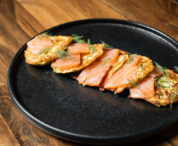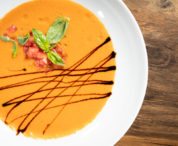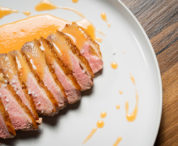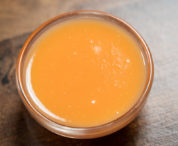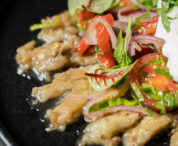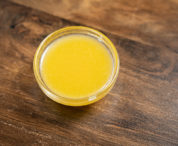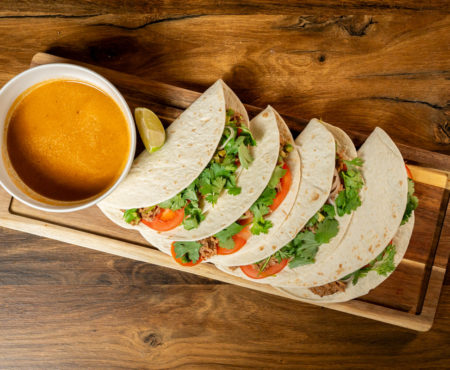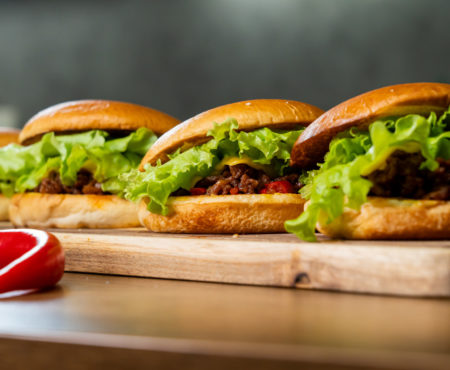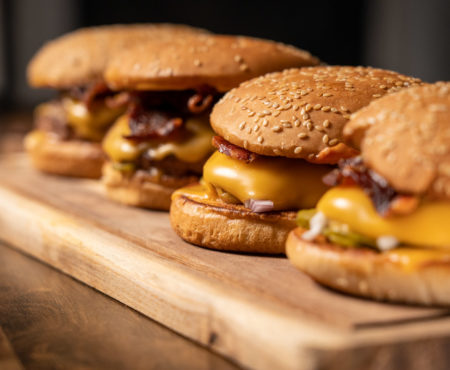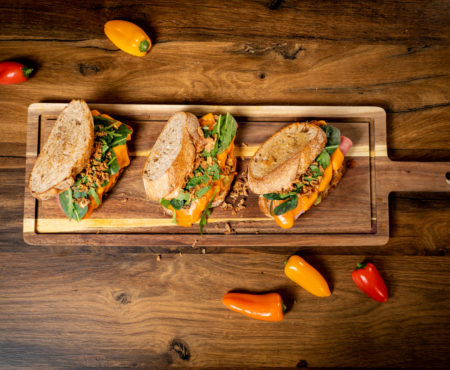The Ultimate Pasta Guide: 27 Types You Must Try
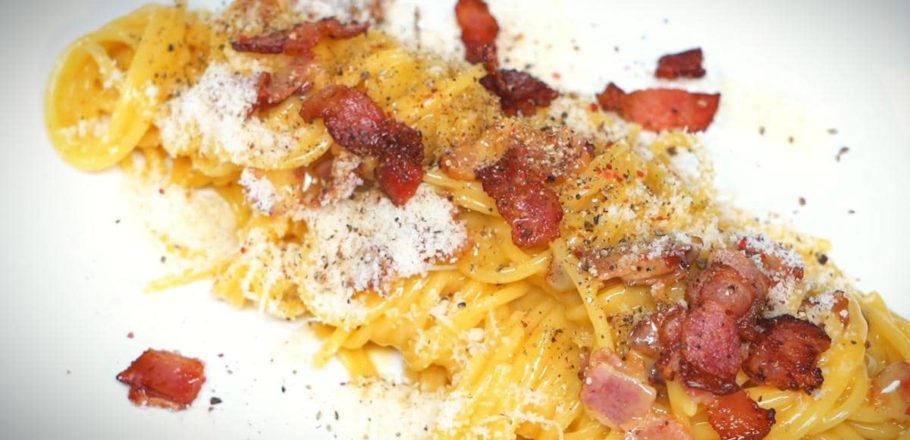
Welcome to the fascinating world of pasta! As a chef with a decade of experience tucked under my apron, I’ve had the joy of working with all sorts of ingredients. Yet, nothing quite compares to the versatility and charm of pasta. In this article, we’re going to dive into 27 different types of pasta, each with its unique shape, history, and best ways to serve them. Whether you’re a seasoned pasta lover or new to the kitchen, this guide will help you navigate the wide, wonderful world of pasta with ease and excitement. So, grab your fork, and let’s twirl our way through the delightful varieties pasta has to offer!
Long Pasta
1 Spaghetti

Spaghetti, one of the most iconic pasta types, has its roots deeply embedded in Italian cuisine, though its exact origin is a subject of debate. Some theories suggest spaghetti could trace back to ancient Roman times, but more concrete evidence points to it flourishing in Southern Italy around the 12th century. Traditionally made from durum wheat semolina, spaghetti has transcended its Italian origins to become a staple in households worldwide.
Main Differences
The main distinguishing feature of spaghetti is its long, thin, cylindrical shape. Unlike its flat counterparts like fettuccine or linguine, spaghetti’s round strands are versatile, making it one of the most popular pasta types. Its diameter can vary slightly, but it is generally around 2mm.
Advantages and Disadvantages
Advantages of spaghetti include its quick cooking time and its ability to cling to various sauces, making it a go-to choice for a quick and flavorful meal. However, one disadvantage might be its uniformity; for those seeking pasta with a heftier bite or more surface area for sauce, spaghetti may not always be the ideal choice.
Best Suited Dishes and Famous Dishes
Spaghetti is exceptionally versatile, making it suitable for a wide array of dishes, from simple garlic and oil (Aglio e Olio) to the classic Spaghetti alla Carbonara. It pairs wonderfully with tomato-based sauces, as in the world-renowned Spaghetti Bolognese, and is also the pasta of choice for Spaghetti alla Puttanesca, featuring a tangy and salty sauce with anchovies, capers, and olives. Its ability to blend seamlessly with both light and robust sauces makes it a perennial favorite in the culinary world.
As a chef with a decade of experience, I’ve had the pleasure of cooking spaghetti in countless ways. It’s a canvas that allows for creativity, whether you’re sticking to traditional recipes or venturing into new culinary territories. The key to perfect spaghetti lies in cooking it to “al dente” – a slight chewiness that retains its structure, allowing it to carry the sauce beautifully from plate to palate.
2 Linguine
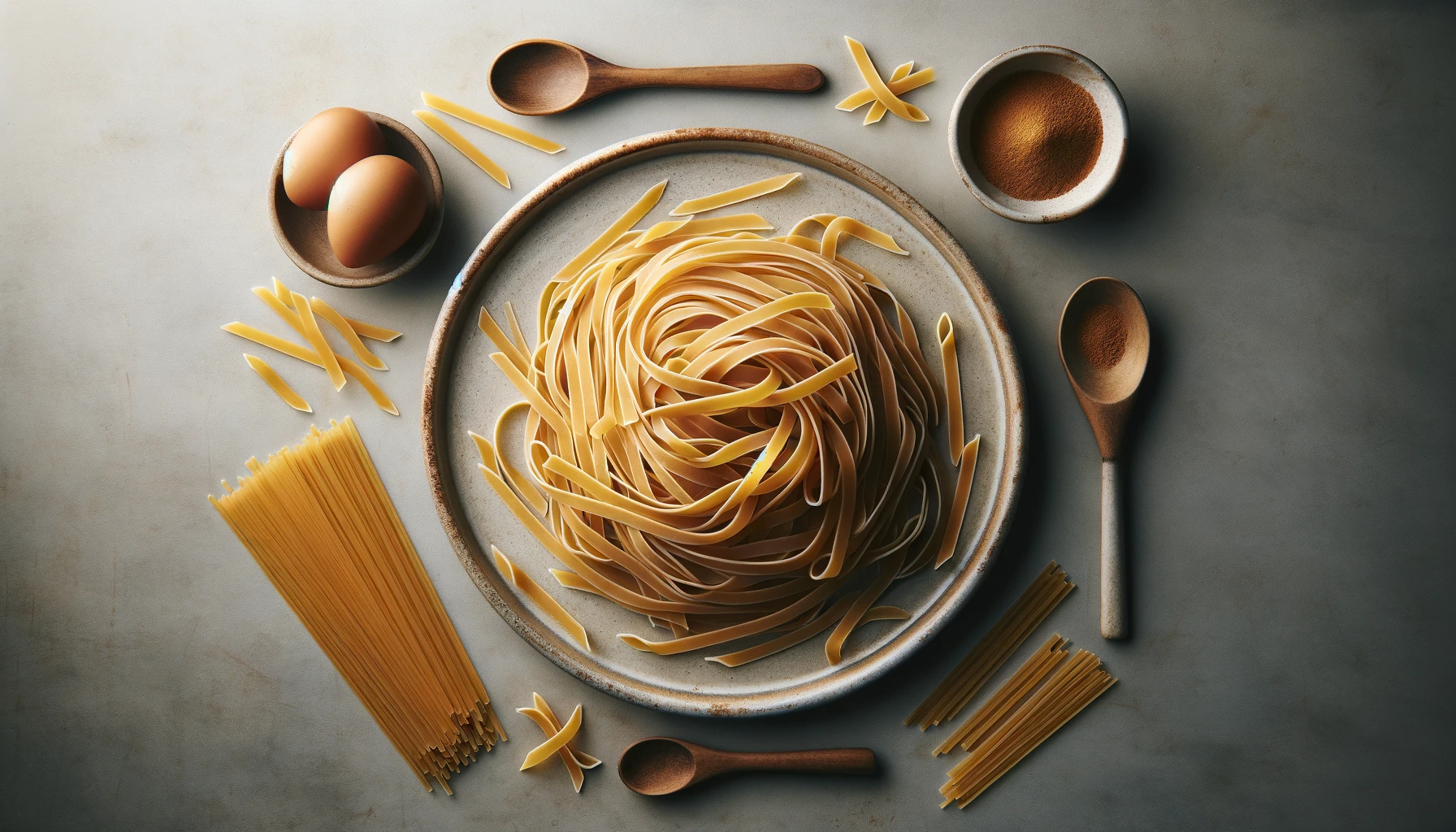
Linguine, meaning “little tongues” in Italian, is a traditional type of pasta originating from the Liguria region of Italy, home to the famed city of Genoa. This pasta, which emerged around the 17th century, is similar to spaghetti but flatter and slightly wider. Crafters made linguine primarily from durum wheat and water to complement the fresh seafood and pesto sauces typical of Ligurian cuisine. Its creation reflects the coastal region’s culinary ingenuity, offering a perfect medium for lighter sauces.
Main Differences
The primary difference between linguine and other long pasta, such as spaghetti, is its elliptical cross-section, which provides a broader surface area. This subtle change in shape allows linguine to hold onto lighter and oil-based sauces more effectively than its round counterparts. Its slightly thicker texture also offers a more substantial bite, making it particularly suited for dishes with delicate flavors.
Advantages and Disadvantages
One of the significant advantages of linguine is its versatility with seafood and vegetable-based sauces, providing a delightful culinary canvas that accentuates the freshness of these ingredients. Additionally, its structure is sturdy enough to support richer, cream-based sauces without becoming overly heavy. On the downside, due to its flat surface, it may clump together more easily than round pasta types if not cooked or tossed properly.
Best Suited Dishes and Famous Dishes
Linguine shines brightest when paired with traditional Ligurian sauces such as Pesto alla Genovese, where its flat surface beautifully carries the basil-rich pesto. It is also the pasta of choice for Linguine alle Vongole, a classic Italian dish featuring clams, garlic, parsley, and a splash of white wine. This pasta also pairs well with lighter tomato-based sauces or simple preparations with fresh herbs and a drizzle of extra virgin olive oil. A testament to its versatility is Linguine with Lemon and Garlic Shrimp, a dish that balances the richness of seafood with the zest of lemon for a refreshing taste.
Preparing linguine has taught me the importance of balance and harmony in ingredients. Cooking linguine “al dente” is crucial, as it retains a texture that complements rather than overwhelms the sauce. Whether it’s the briny depth of a seafood sauce or the bright, herby notes of pesto, linguine serves as an exquisite foundation that elevates the dish’s overall flavor profile.
3 Fettuccine
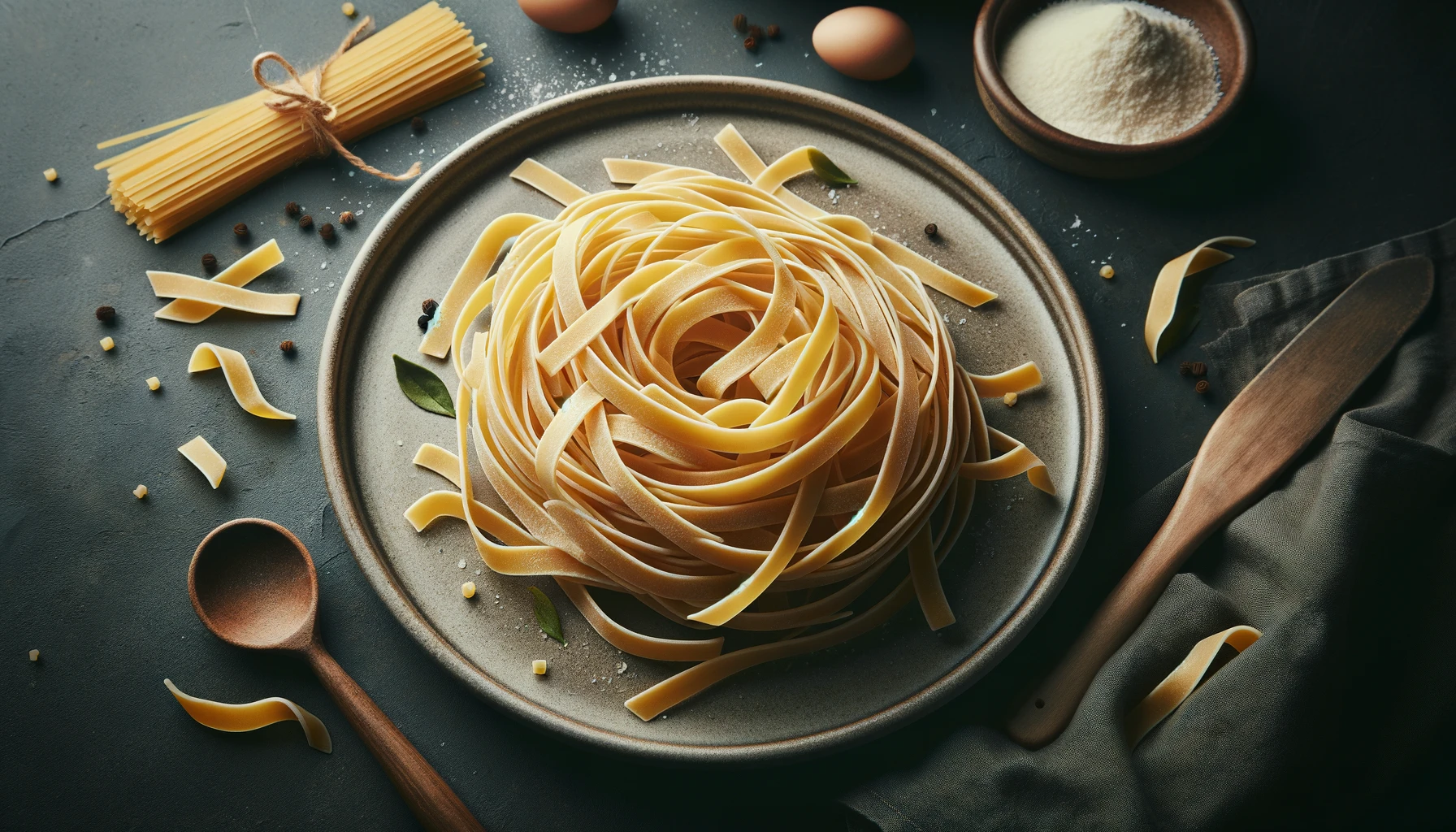
Fettuccine, which means “little ribbons” in Italian, is a type of pasta that hails from the heart of Italy, particularly Rome. Its egg-based composition makes it renowned for creating a rich and tender noodle that’s perfect for absorbing sauces. The history of fettuccine goes back centuries, reflecting the simplicity and elegance of Italian cuisine. This pasta has been a staple in Roman and Tuscan kitchens, where the combination of eggs, flour, and meticulous preparation results in a dish that is both hearty and refined.
Main Differences
Fettuccine’s distinctive feature is its shape: flat, thick noodles that are about 6-7 mm wide. This width makes fettuccine more substantial than spaghetti or linguine, allowing it to pair well with thicker, creamier sauces. Unlike thinner pasta that may become overwhelmed by heavy sauces, fettuccine provides a satisfying texture and surface area that enhances sauce adherence.
Advantages and Disadvantages
One of the main advantages of fettuccine is its ability to serve as a hearty base for robust sauces, making it a favorite for rich, creamy dishes. The thickness and texture of the pasta contribute to a luxurious eating experience, infusing every bite with flavor. However, this same characteristic can overshadow lighter, more delicate sauces due to the pasta’s heft.
Best Suited Dishes and Famous Dishes
Fettuccine perhaps gains the best recognition from its key role in Fettuccine Alfredo, a dish that has achieved international fame for its simplicity and richness. The creamy Alfredo sauce, made with butter and Parmesan cheese, clings perfectly to the fettuccine, creating a comforting dish that’s both indulgent and satisfying. Beyond Alfredo, fettuccine also excels in dishes with hearty meat ragùs or vegetable-based sauces that can stand up to the pasta’s texture. In my culinary experience, incorporating fresh, high-quality ingredients into the sauce—whether it’s a classic Bolognese or a more contemporary preparation with wild mushrooms and truffle oil—makes all the difference in elevating fettuccine to its full potential.
In my decade of cooking, I’ve come to appreciate fettuccine’s versatility and resilience. Achieving the perfect “al dente” texture is key; it should be firm to the bite, yet tender, a balance that allows the pasta to meld seamlessly with the sauce. My advice to fellow chefs and home cooks alike is to not shy away from experimenting with fettuccine, as its robust nature makes it an excellent canvas for culinary creativity.
4 Tagliatelle

Tagliatelle, a classic of the Italian pasta family, hails predominantly from the Emilia-Romagna and Marche regions of Italy, areas known for their rich culinary traditions. This pasta’s name derives from the Italian verb “tagliare,” meaning “to cut,” a nod to the process of cutting the pasta dough into long, ribbon-like strips. Its history intertwines with the fabric of Italian food culture, often celebrating it alongside Bolognese sauce in the iconic dish Tagliatelle al Ragù. Folklore, including a popular but apocryphal tale involving Lucrezia Borgia’s wedding in 1487, steeps the precise origins of tagliatelle, suggesting inspiration from her hair for the pasta. What’s clear, however, is that tagliatelle has been a beloved staple in Italian cuisine for centuries.
Main Differences
Tagliatelle’s defining characteristic is its long, flat ribbons, similar in width to fettuccine but traditionally a bit narrower. This pasta is about 6-8 mm wide when cooked, ideally suited to cling to rich, meaty sauces. The main difference between tagliatelle and similar pasta like fettuccine or linguine lies in its traditional preparation and regional pairing with specific sauces, especially the hearty ragù typical of the Emilia-Romagna region.
Advantages and Disadvantages
The advantage of tagliatelle lies in its texture and surface area, which are perfect for absorbing and holding onto thick sauces, ensuring that each bite is flavorful. This pasta provides a delightful contrast between its tender, chewy texture and the richness of traditional Italian sauces. A potential disadvantage might be its similarity to other flat pasta, which can lead to confusion in identifying the best pasta-sauce pairings, although this also speaks to its versatility.
Best Suited Dishes and Famous Dishes
Tagliatelle is synonymous with Tagliatelle al Ragù, a dish where it serves as the perfect foundation for the slow-cooked, savory depth of Bolognese sauce. Beyond this classic pairing, tagliatelle also excels with cream-based sauces like Tagliatelle with Porcini Mushrooms and Truffle, where its broad surface beautifully carries the earthy flavors of the fungi and the aromatic truffle. It also suits simpler preparations that highlight quality ingredients well, such as Tagliatelle with Fresh Basil Pesto or Tagliatelle with Butter and Parmigiano-Reggiano.
In over a decade of culinary practice, I’ve found that the key to perfecting tagliatelle lies in the dough’s texture and the pasta’s cooking time. An “al dente” finish is crucial—it should retain a slight resistance when bitten, creating a harmonious blend with the sauce. From my experience, whether you’re serving a traditional ragù or a lighter, vegetable-based sauce, the quality of ingredients and the love put into the cooking process shine through in every forkful of tagliatelle.
5 Capellini (Angel Hair)
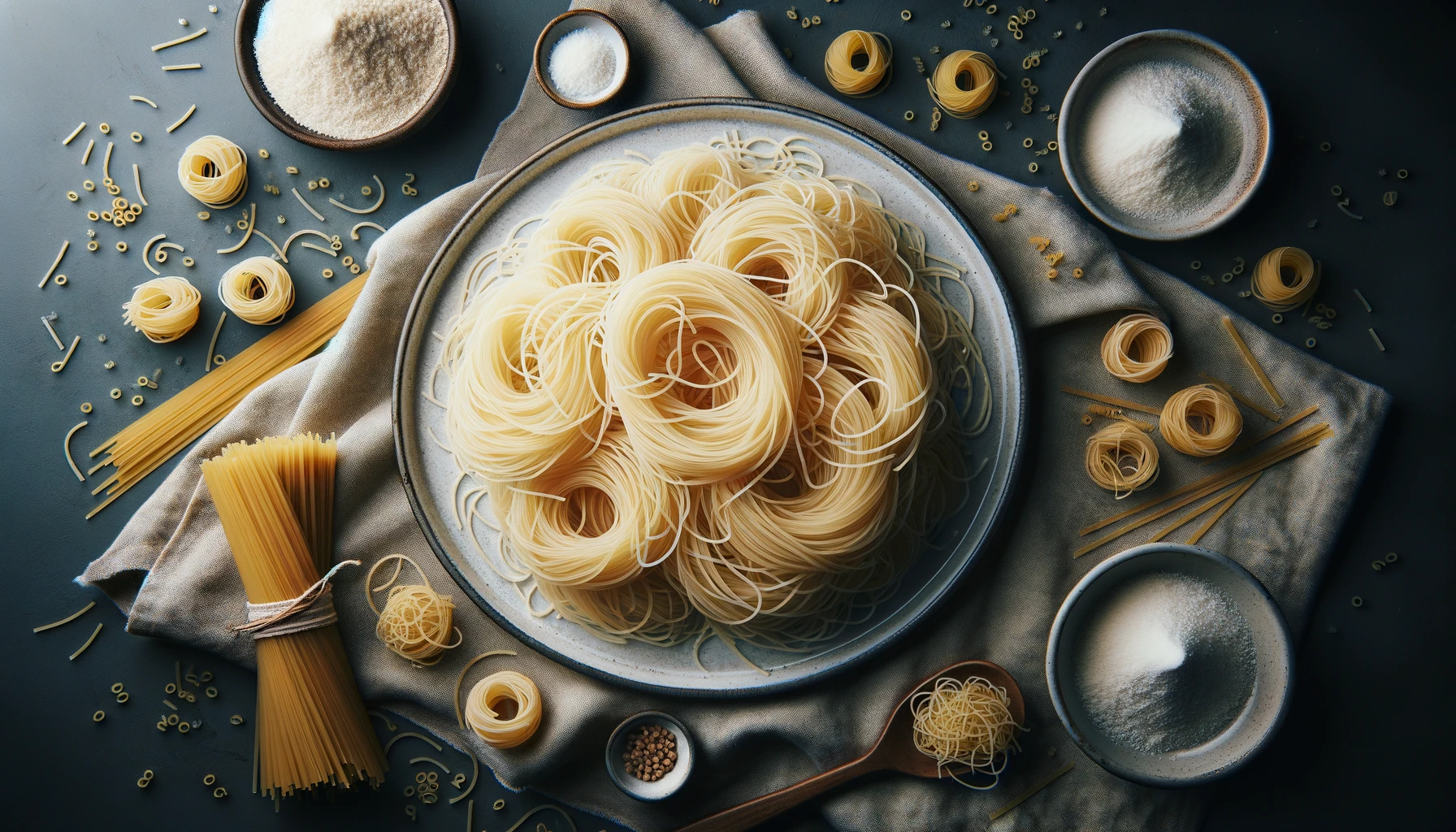
Capellini, often referred to as “Angel Hair” pasta due to its extremely fine strands, is a delicate variety of Italian pasta. Different regions of Italy claim its origins, celebrating it for its quick cooking time and light texture. Capellini embodies the Italian culinary principle of simplicity, designed to complement rather than overwhelm with its presence in a dish.
Main Differences
The defining feature of capellini is its thinness, making it one of the finest pasta types available, significantly thinner than spaghetti. This characteristic allows it to cook very quickly, making it an excellent choice for meals that require minimal preparation time.
Advantages and Disadvantages
The advantage of capellini lies in its delicate texture and ability to absorb flavors rapidly, perfect for light, oil-based sauces or broths. However, its fine nature can also be a disadvantage, as it is prone to overcooking and clumping together if not monitored carefully during cooking.
Best Suited Dishes and Famous Dishes
Capellini pairs ideally with light, delicate sauces, such as Capellini al Limone, where the zest and juice of lemons create a refreshing, light sauce that clings to the pasta without weighing it down. It is also perfect in broth-based dishes or light tomato sauces, offering a quick and satisfying meal. Seafood dishes, like Capellini with Shrimp and Garlic, highlight the pasta’s ability to complement the subtlety of seafood without competing for flavor.
6 Vermicelli
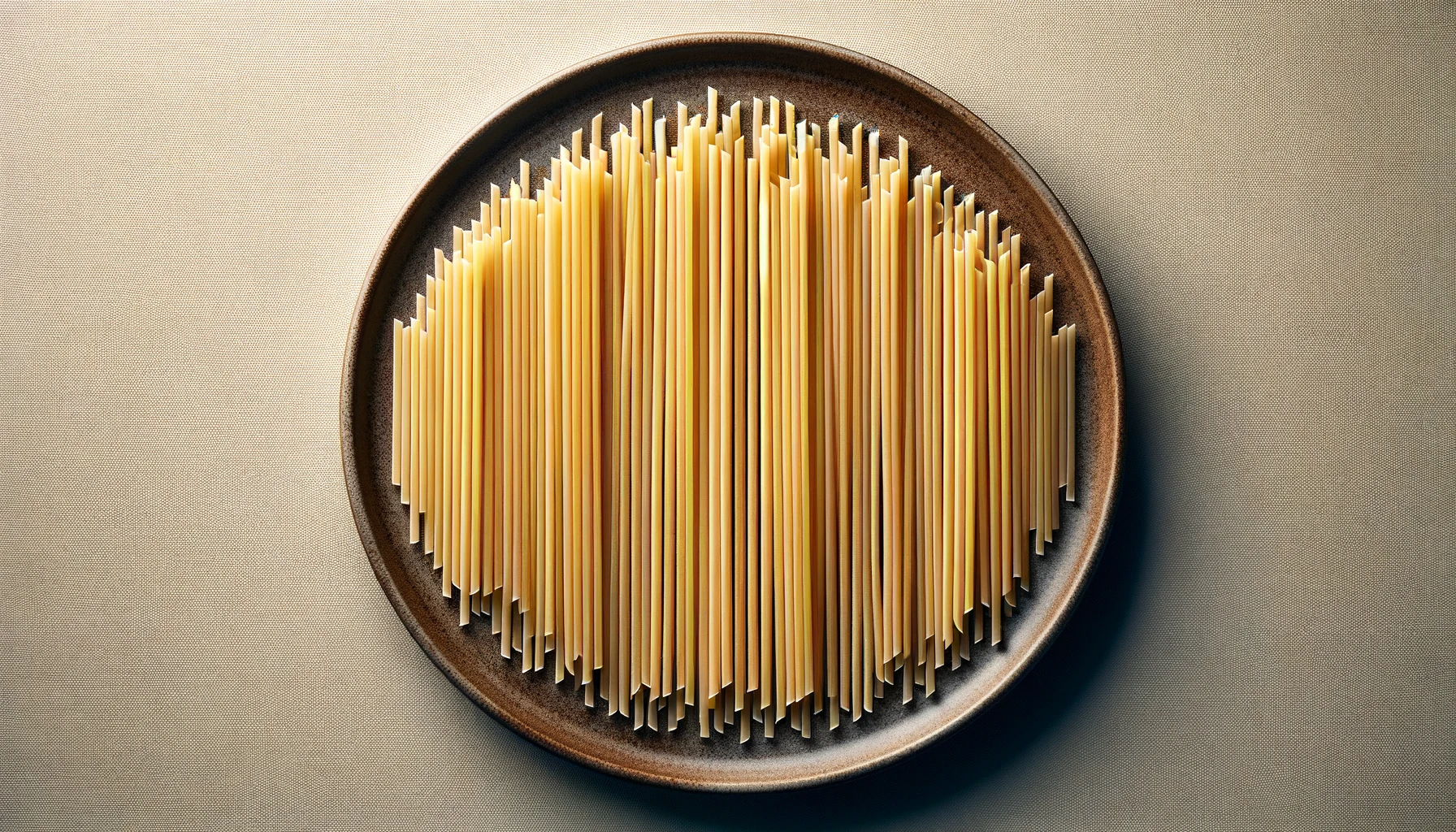
Vermicelli, which means “little worms” in Italian, is a traditional type of pasta that is thinner than spaghetti but thicker than capellini. It is popular not only in Italy but also in various forms across Asian cuisines, showcasing its versatility and adaptability to different culinary traditions.
Main Differences
Vermicelli’s main characteristic is its thin, round shape, offering a lighter option than spaghetti but with more body than angel hair pasta. This makes it a versatile choice for a range of dishes, bridging the gap between delicate and hearty pasta meals.
Advantages and Disadvantages
An advantage of vermicelli is its quick cooking time and its ability to mix well with a variety of sauces, from light olive oil-based dressings to more substantial tomato sauces. However, its thinness can lead to overcooking if not carefully watched, potentially resulting in a mushy texture.
Best Suited Dishes and Famous Dishes
In Italian cuisine, chefs often use Vermicelli in seafood dishes, such as Vermicelli with Clams or garlic and oil sauce, where its lightness complements the delicate flavors of the seafood. It’s also popular in soups and broths, providing a satisfying but not overwhelming pasta experience.
7 Pappardelle
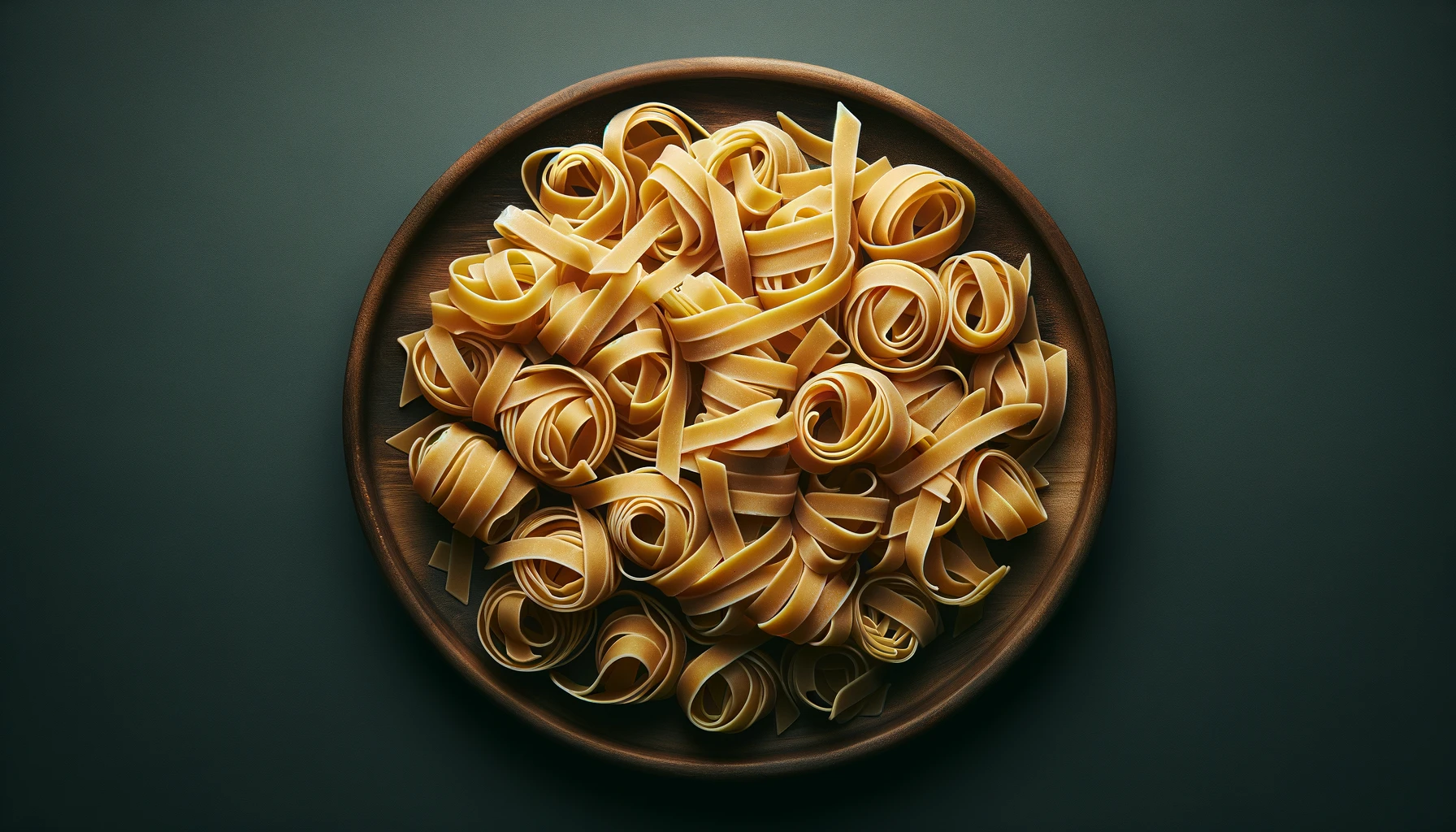
Pappardelle, a broad, flat ribbon-like pasta, holds a cherished place in Italian cuisine, especially in the Tuscan region, where chefs often pair it with hearty, meat-based sauces. Its name, deriving from the Italian verb “pappare,” meaning to gobble up, perfectly encapsulates the satisfying experience of enjoying this substantial pasta.
Main Differences
Pappardelle stands out due to its width, which is significantly broader than that of spaghetti or even tagliatelle, making it one of the widest types of flat pasta available. This characteristic allows it to support rich, chunky sauces that might overwhelm thinner pasta types.
Advantages and Disadvantages
The advantage of pappardelle is its ability to complement robust sauces, providing a hearty meal that is both filling and flavorful. It’s particularly suited for capturing the nuances of slow-cooked ragùs. A potential disadvantage is its size, which can make it slightly more challenging to cook evenly and requires a bit more skill to achieve the perfect “al dente” texture.
Best Suited Dishes and Famous Dishes
Pappardelle is best known for its pairing with game meats, such as in the classic Pappardelle al Cinghiale (wild boar ragù), a dish that showcases its ability to stand up to intense flavors and textures. It is also excellent with other rich sauces, like a slow-cooked beef or lamb ragù, offering a comforting and indulgent dining experience that highlights the pasta’s versatility and satisfying nature.
Short Pasta
8 Penne
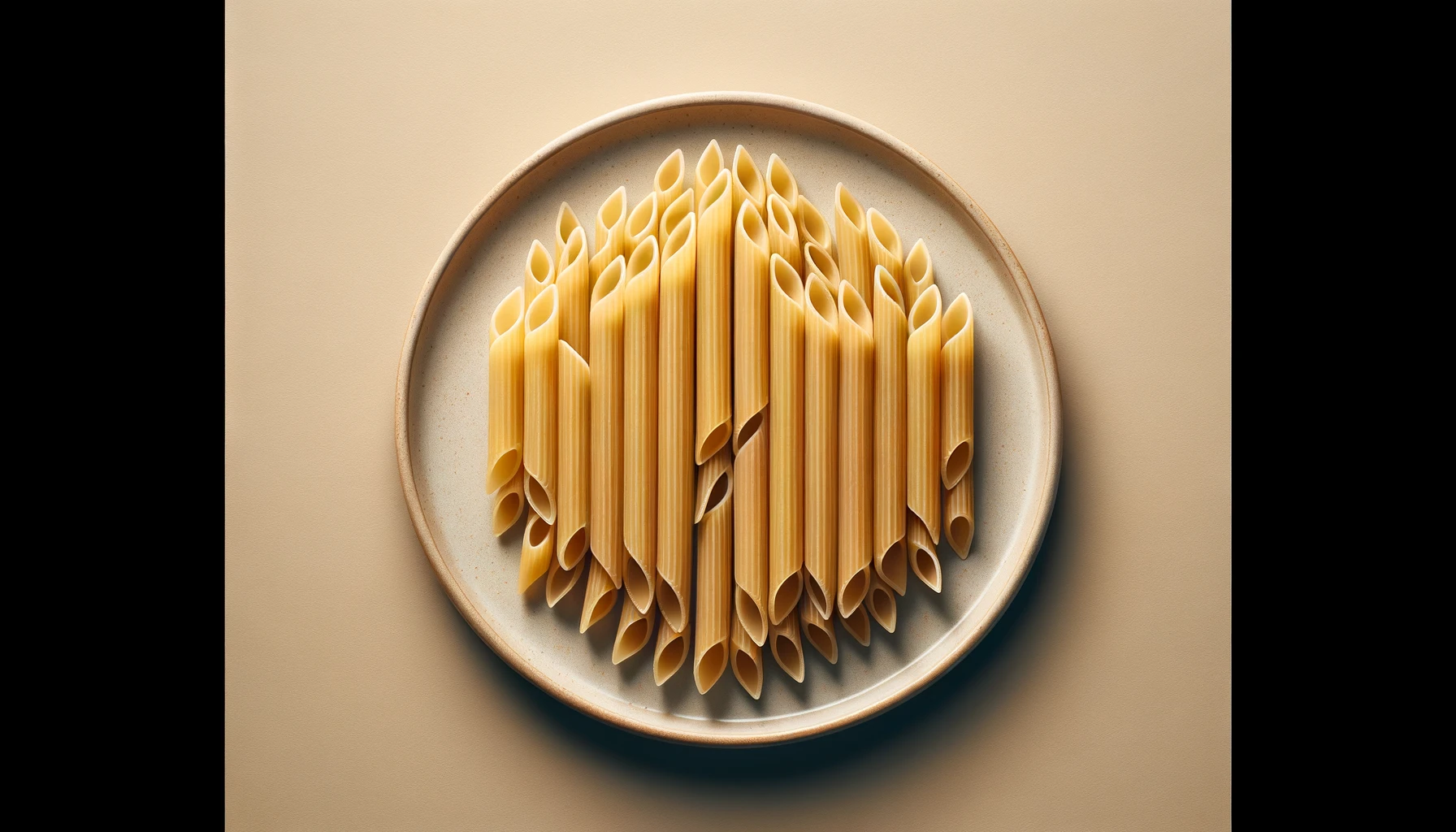
Penne is one of the most popular pasta shapes, characterized by its cylindrical shape and diagonal cuts. Originating from the Campania region of Italy, penne translates to “quills” or “feathers,” reflecting its resemblance to the pointed quill pens used for writing in ancient times. There are two main types: penne lisce (smooth) and penne rigate (ridged), with the ridges helping to hold onto sauces.
Main Differences
The distinct tube shape and sharp angled ends of penne allow it to hold sauces well, making it versatile for a variety of dishes. The ridges in penne rigate add texture and increase the surface area for sauce adherence.
Advantages and Disadvantages
Penne’s advantages include its suitability for a wide range of sauces, from creamy to chunky meat sauces. Its shape also ensures it cooks evenly. A disadvantage might be its commonality, which can overshadow the many other types of pasta available with different textures and sauce pairing abilities.
Best Suited Dishes and Famous Dishes
Penne is famously used in Penne alla Vodka, where the pasta’s shape perfectly captures the creamy tomato sauce. It’s also ideal for baked pasta dishes like Baked Ziti, pasta salads, and robust meat or vegetable sauces.
9 Rigatoni
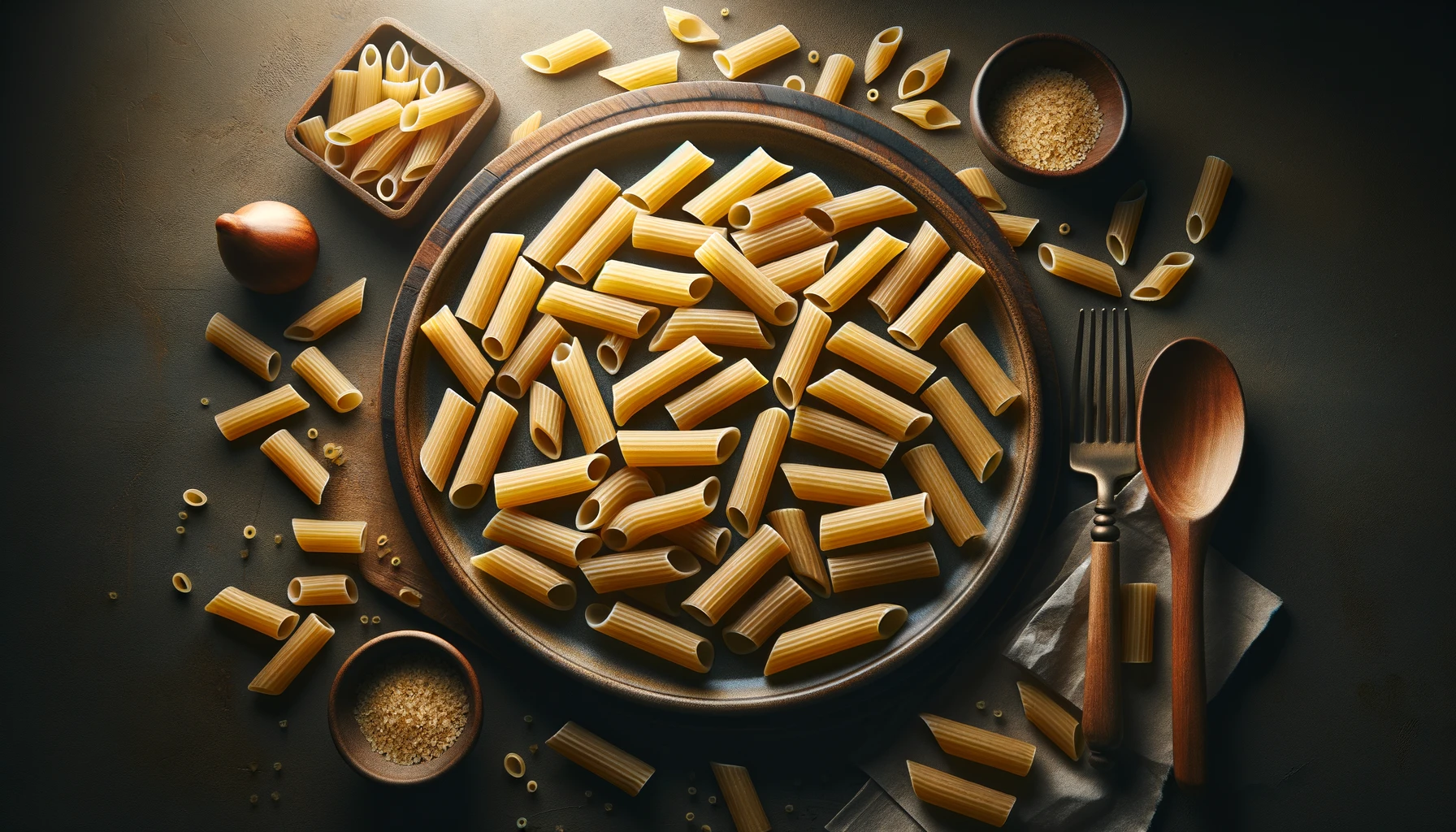
Rigatoni is a large, tube-shaped pasta originating from Italy, particularly popular in Rome and the surrounding Lazio region. Its name comes from the Italian word “rigato,” meaning ridged, which describes its characteristic lines that run down the pasta’s length. Rigatoni’s large diameter and ridges make it excellent for holding onto every kind of sauce.
Main Differences
Rigatoni’s distinguishing features are its ridges and wider, square-cut ends compared to penne’s angled ends. This shape allows for an exceptional sauce-to-pasta ratio, with the ridges catching and holding sauce and the hollow center filling with delicious bits of meat, vegetables, or cheese.
Advantages and Disadvantages
The advantage of rigatoni lies in its ability to pair well with a wide array of sauces, especially chunky sauces that benefit from the pasta’s large holes and ridges. However, due to its size, it may not be as suitable for lighter, more delicate sauces.
Best Suited Dishes and Famous Dishes
Rigatoni is well-suited for hearty dishes like Rigatoni with Pork Ragù or Rigatoni alla Norma, with eggplant and ricotta. Its robust shape makes it a favorite for baked pasta dishes as well, offering a satisfying bite and an excellent sauce-carrying capacity.
10 Macaroni

Macaroni is a type of dry pasta shaped like narrow tubes. Made from durum wheat, it is one of the most recognizable pasta shapes worldwide, often associated with comfort food. The name “macaroni” comes from the Italian “maccheroni,” with roots suggesting a mixture of pasta and dough. Macaroni’s simple shape and texture have made it a staple in American cuisine, especially in the form of macaroni and cheese.
Main Differences
Macaroni is typically shorter and narrower than other tubular pastas such as penne and rigatoni. Its straight, tubular shape without ridges differentiates it, making it particularly well-suited for creamy sauces that can coat the pasta inside and out.
Advantages and Disadvantages
The primary advantage of macaroni is its versatility in various dishes, from soups to casseroles and salads. Its size and shape make it especially popular in baked dishes. A possible disadvantage is its lack of texture compared to ridged pastas, which may result in less sauce adherence.
Best Suited Dishes and Famous Dishes
Macaroni is famously used in Macaroni and Cheese, where its shape perfectly encapsulates the creamy cheese sauce. It’s also a key ingredient in American-style pasta salads and casseroles, where its simplicity allows the flavors of the other ingredients to shine through.
11 Fusilli
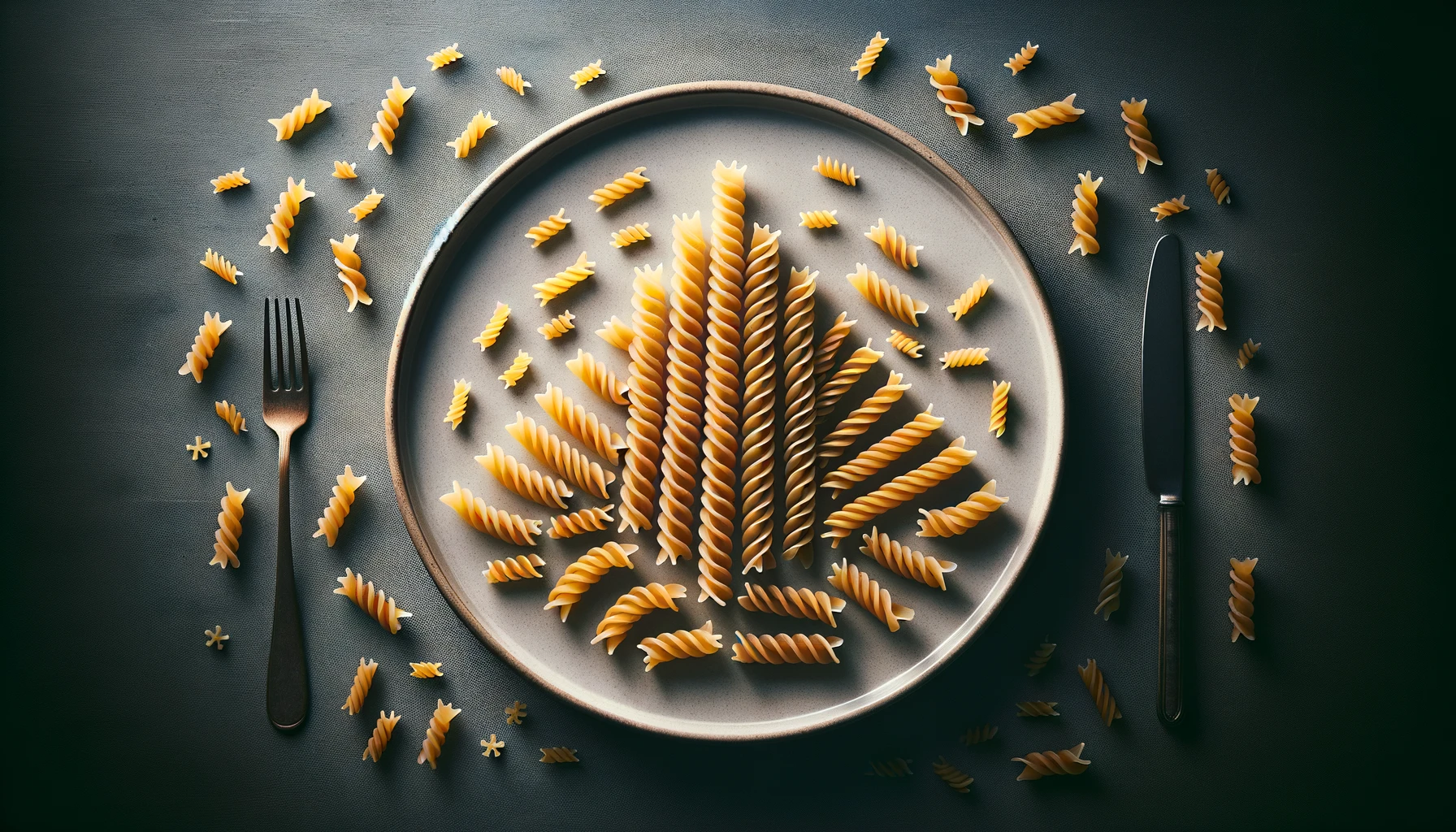
Fusilli are twisted pasta spirals that originate from Southern Italy. The name “fusilli” presumably comes from “fuso,” meaning spindle, as the pasta was traditionally spun by pressing and rolling a small rod over thin strips of pasta to wind them around it in a corkscrew shape. This unique form allows fusilli to catch and hold sauces very effectively.
Main Differences
Fusilli’s tight spirals set it apart from smoother, straighter pasta shapes. This design traps and holds onto both fine and chunky sauces, making every bite flavorful.
Advantages and Disadvantages
The advantage of fusilli lies in its ability to work well with a wide variety of sauces, from light to hearty. Its spirals can also add a pleasing texture to pasta salads. The disadvantage might be its cooking time, which can be longer than some simpler shapes, requiring attention to achieve the perfect texture.
Best Suited Dishes and Famous Dishes
Fusilli is ideal for dishes with rich, thick sauces, such as Fusilli with Creamy Mushroom Sauce or Fusilli al pesto. Its shape makes it excellent for pasta salads, where it can hold onto dressing and mix well with other ingredients.
12 Farfalle (Bow Tie or Butterfly Pasta)
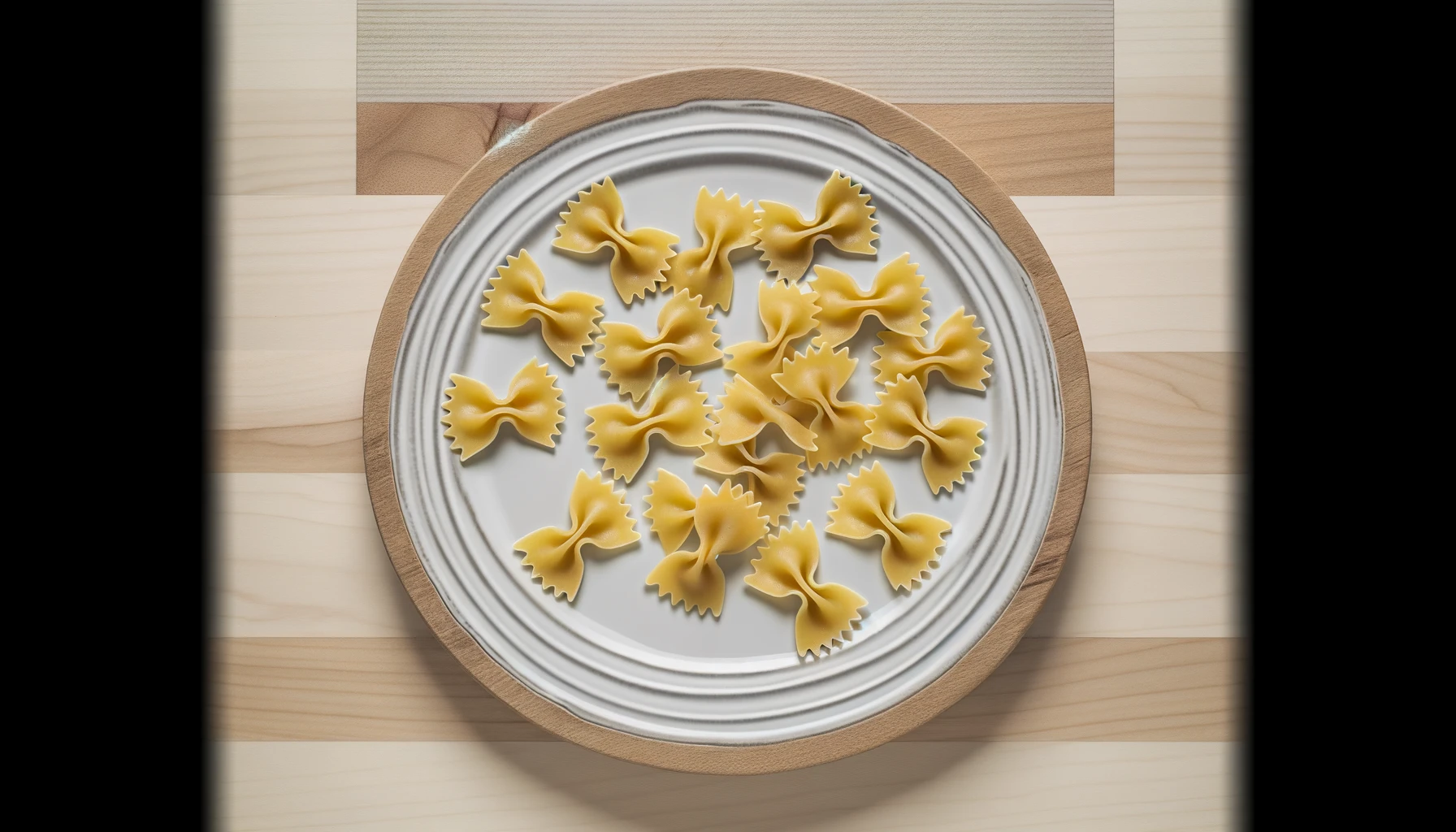
Farfalle, known for its “bow-tie” or “butterfly” shape, is a type of pasta that dates back to the 16th century in the Lombardy and Emilia-Romagna regions of Italy. The name farfalle means “butterflies” in Italian, and it is made by cutting fresh pasta into rectangles and pinching the centers together to form a distinctive shape.
Main Differences
Farfalle’s unique shape includes a pinched middle and flared edges, resembling a bow tie or butterfly. This design allows for a varied texture in each bite, with the center being slightly thicker and the edges offering a tender bite.
Advantages and Disadvantages
An advantage of farfalle is its aesthetic appeal and the way its shape can add a playful element to dishes, along with a varied texture. However, its thicker center can be a disadvantage as it requires careful cooking to ensure even doneness without overcooking the thinner edges.
Best Suited Dishes and Famous Dishes
Farfalle is best suited for light to medium sauces that cling to its surfaces, such as Farfalle with Spinach and Ricotta or Farfalle al salmone. It’s also popular in pasta salads, where its shape can catch and hold smaller ingredients, like peas or diced vegetables.
13 Rotini
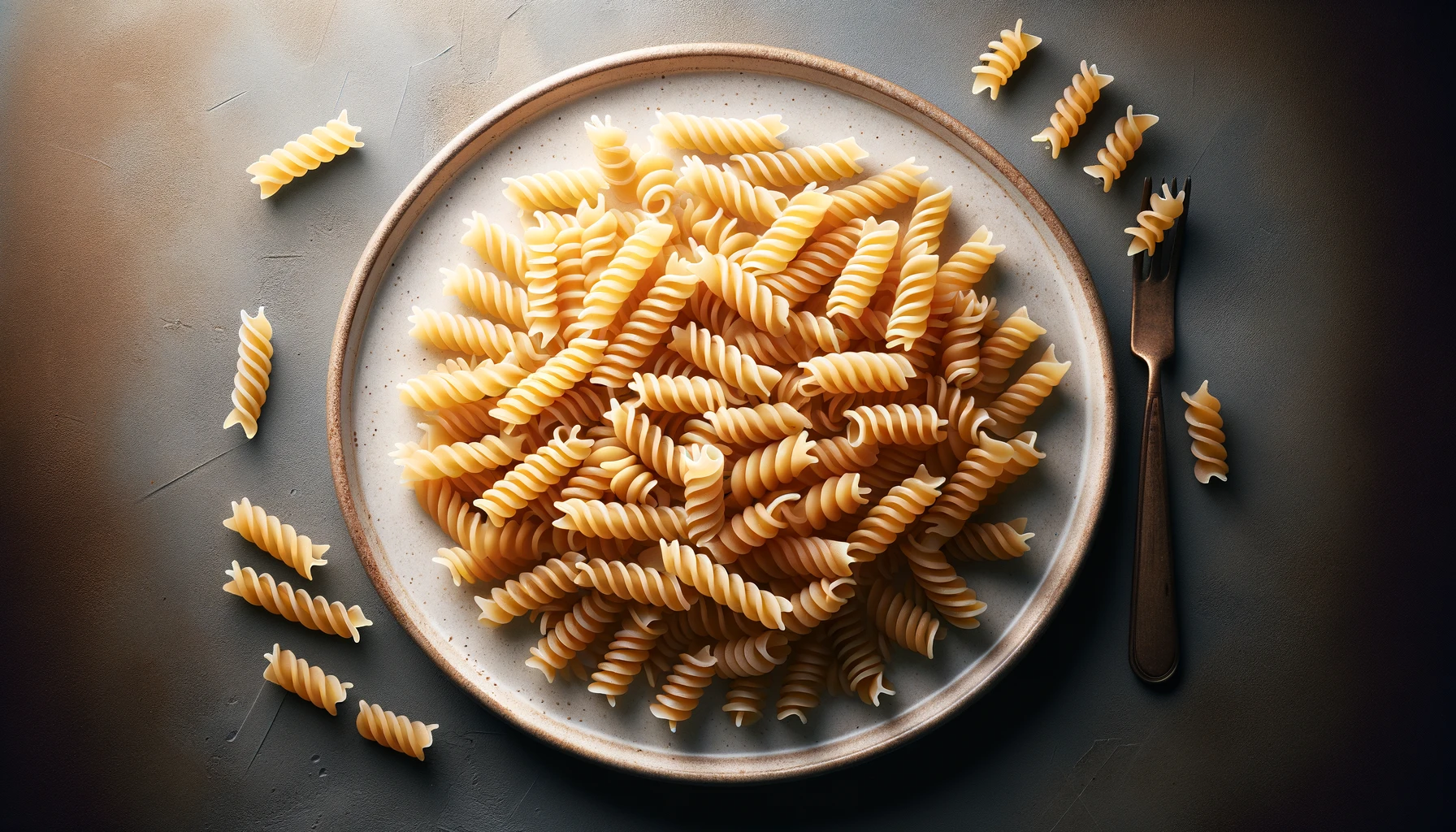
Rotini, meaning “spirals” or “twists” in Italian, is a pasta similar in shape to fusilli but with a more compact spiral. It’s designed to hold onto sauces with its grooves and curves, making it a favorite for both hot dishes and cold pasta salads. The shape is particularly popular in American cuisine, where it’s appreciated for its fun appearance and practicality.
Main Differences
Rotini is characterized by its tighter spirals compared to fusilli’s longer, more pronounced twists. This shape allows for excellent sauce retention and gives a pleasing texture to the pasta dish.
Advantages and Disadvantages
The primary advantage of rotini is its ability to capture and hold a wide variety of sauces, making it versatile for many recipes. The disadvantage might be its similarity to other spiral pastas, which can be confusing; however, its tighter twists provide a distinct texture and appearance.
Best Suited Dishes and Famous Dishes
Rotini is well-suited for pasta salads, where its spirals can pick up and hold onto dressing, making every bite flavorful. It’s also great with chunky vegetable or meat sauces, where the crevices catch small pieces, ensuring a well-distributed sauce throughout the dish.
14 Orecchiette
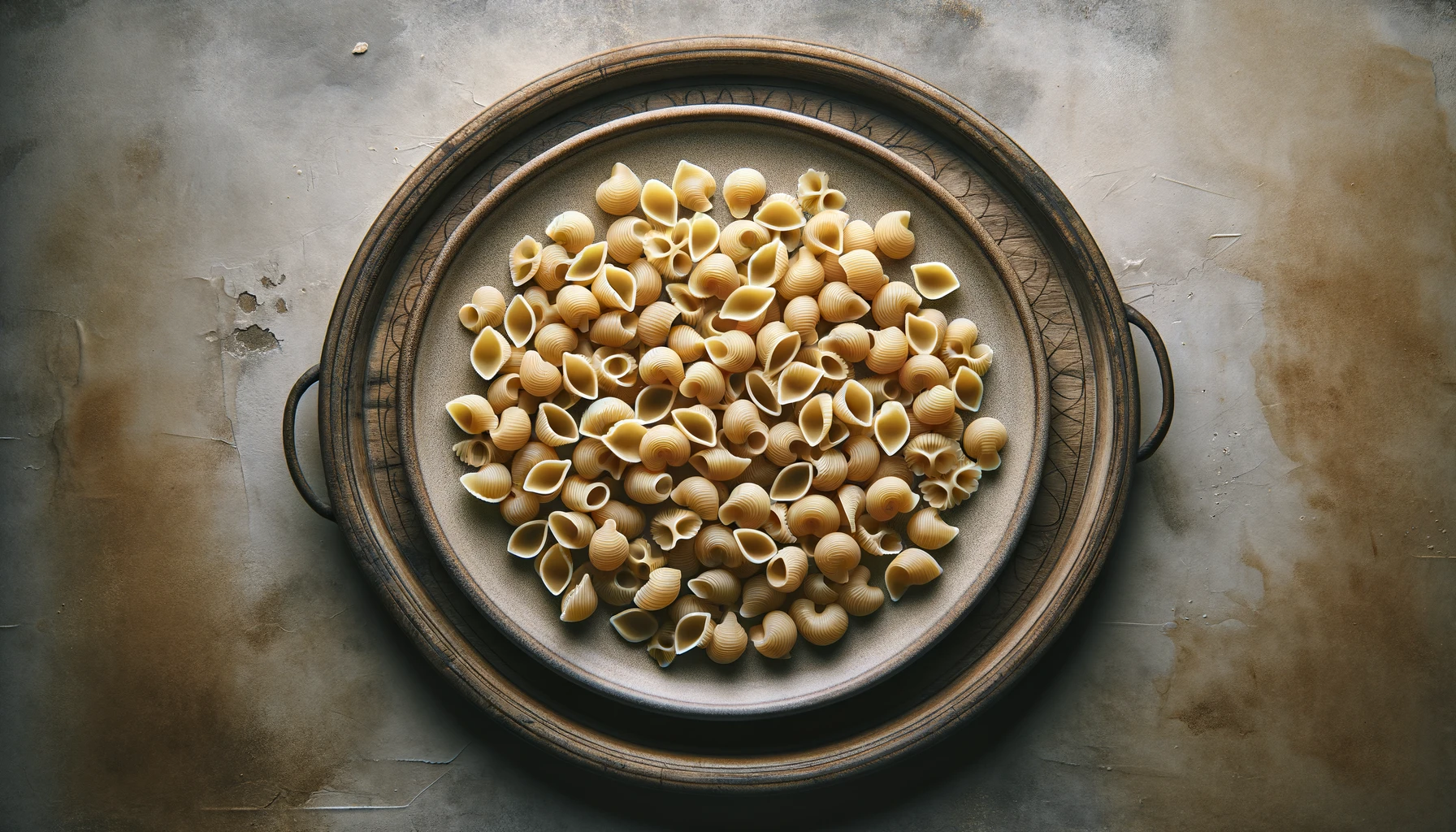
Orecchiette, which means “little ears” in Italian, is a pasta typical of the Puglia region of Southern Italy. The shape resembles small, round, concave discs, with a texture that’s smooth on the outside and slightly rough on the inside. Traditionally made by hand, orecchiette has a homemade charm that’s celebrated in Italian cuisine.
Main Differences
Orecchiette’s unique ear-like shape sets it apart from other pasta types. Its concave center is excellent for catching thicker, chunkier sauces, while its slightly rough texture helps to adhere to lighter sauces.
Advantages and Disadvantages
The advantage of orecchiette lies in its ability to scoop up bits of sauce and ingredients, making for flavorful bites. However, its unique shape can require careful cooking to ensure the pasta cooks evenly throughout.
Best Suited Dishes and Famous Dishes
Orecchiette is famously paired with cime di rapa (broccoli rabe) in Orecchiette con Cime di Rapa, a dish that highlights the pasta’s ability to capture the bitter greens and garlic in each bite. It’s also excellent with meaty sauces or simple tomato and basil sauces.
15 Cavatappi
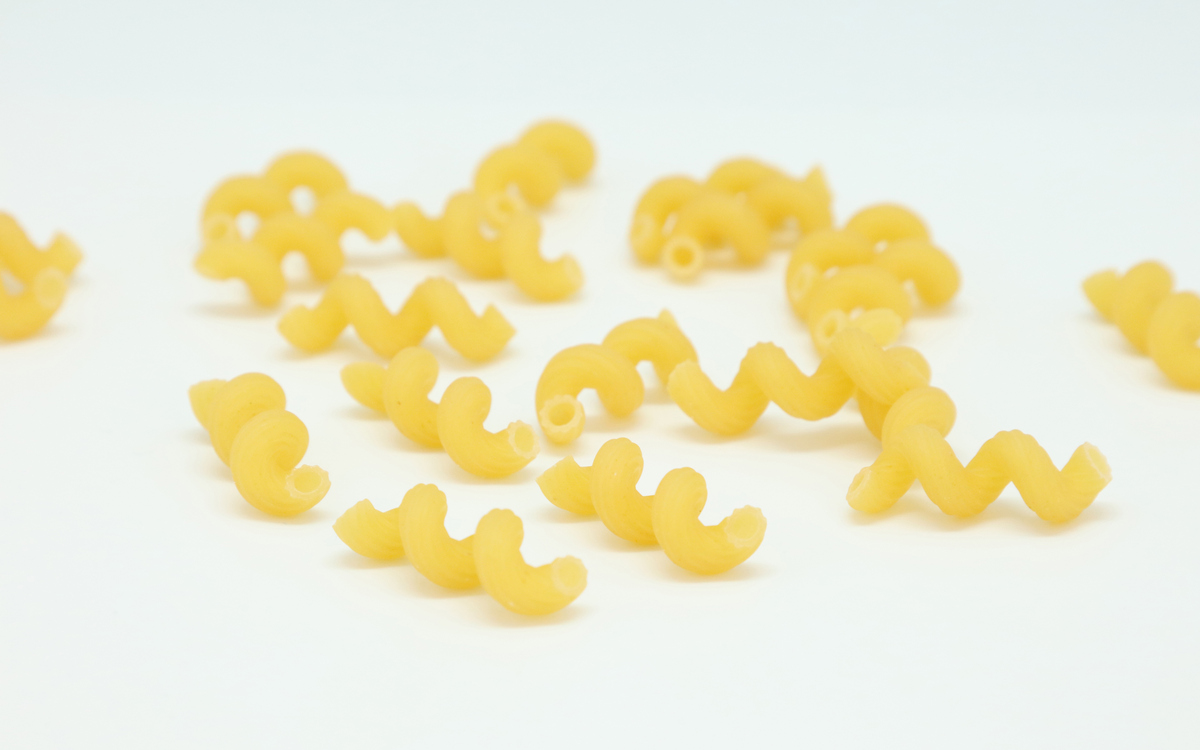
Cavatappi, which translates to “corkscrews” in Italian, is a spiral, tube-shaped pasta with ridges. Its unique shape is derived from its helical, screw-like appearance, making it a playful yet practical choice for a variety of dishes. Originating from Northern Italy, cavatappi has become popular worldwide for its fun shape and versatility.
Main Differences
Cavatappi’s helix shape and hollow center distinguish it from other pasta types. The ridges on its surface are perfect for gripping onto both creamy and chunky sauces, while the hollow center allows the sauce to flow through, ensuring a flavorful experience with every bite.
Advantages and Disadvantages
An advantage of cavatappi is its appealing texture and the way it holds sauces, making it ideal for a wide range of pasta dishes. The only potential disadvantage might be its length and curves, which can make it slightly more challenging to eat neatly compared to straight pasta types.
Best Suited Dishes and Famous Dishes
Cavatappi excels in dishes with thick, hearty sauces, such as Cavatappi with Meatball Marinara or Cavatappi in Creamy Cheese Sauce. It’s also perfect for pasta salads, where its shape can catch and hold onto smaller bits of vegetables and dressing, adding both flavor and visual appeal to the dish.
Stuffed Pasta
16 Ravioli
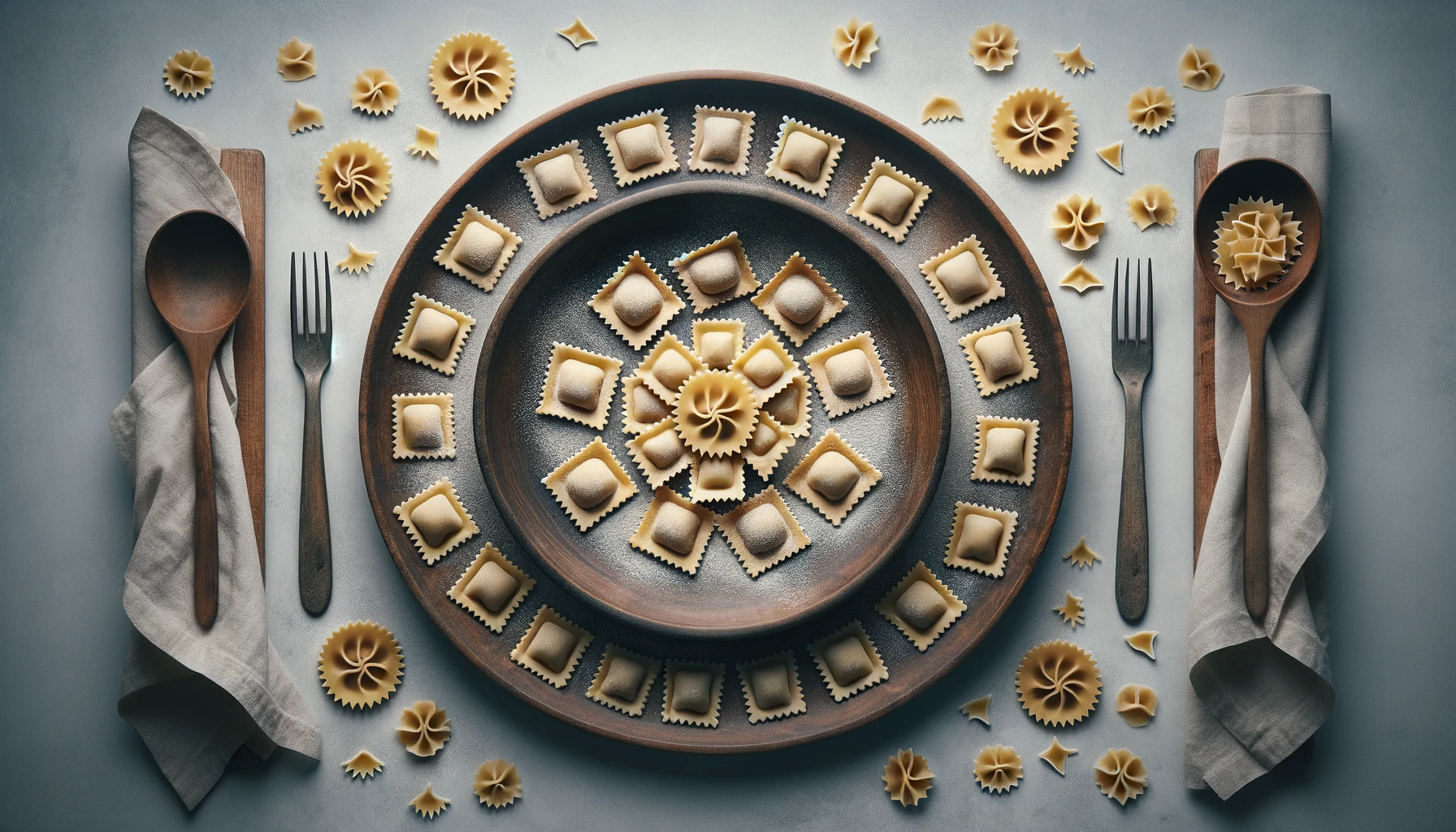
Ravioli, one of the most celebrated stuffed pastas, has its origins in the Italian culinary tradition, with references dating back to the 14th century. This pasta consists of a filling, which can range from meats, cheeses, vegetables, or even seafood, encased in thin pasta dough. The exact origins of ravioli are a bit of a mystery, with various regions of Italy claiming its invention, but it is a staple in Italian feasts, particularly as part of traditional Sunday dinners and special occasions.
Main Differences
Ravioli sets itself apart with its square or round shape and its enclosed stuffing, offering a unique taste experience with each bite. The diversity of fillings and sauces with which ravioli can be served highlights its versatility.
Advantages and Disadvantages
The advantage of ravioli lies in its ability to encapsulate a wide array of flavors within its pasta shell, providing a complete dish in each piece. However, ravioli can be labor-intensive to prepare from scratch and requires careful cooking to ensure the filling is properly heated without overcooking the pasta.
Best Suited Dishes and Famous Dishes
Ravioli is famously served with a simple sage and butter sauce, which allows the flavors of the filling to shine through. It can also be found in heartier dishes, served with robust tomato or cream-based sauces. Spinach and ricotta-filled ravioli is a classic combination, as is pumpkin ravioli in autumn, offering a seasonal twist on this versatile pasta.
17 Tortellini
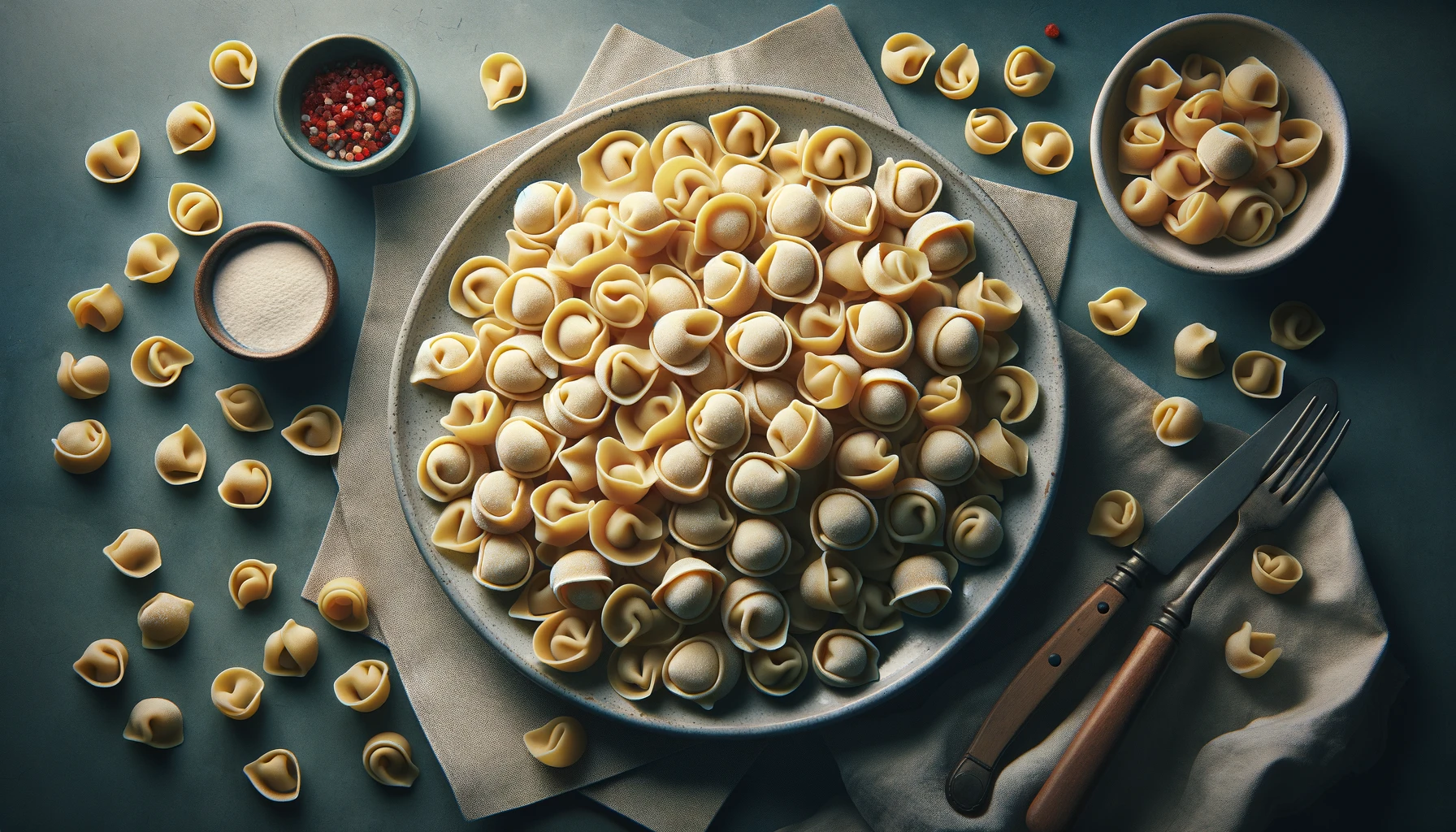
Tortellini is a ring-shaped stuffed pasta that originates from the Emilia-Romagna region of Italy, particularly associated with the city of Bologna. The pasta is traditionally filled with a mixture of meats, such as prosciutto, mortadella, and Parmigiano Reggiano cheese. The origin of tortellini is steeped in Italian folklore, with tales attributing its shape to the navel of Venus, the Roman goddess of love.
Main Differences
Tortellini’s distinctive ring shape and meat-based filling set it apart from other stuffed pastas. It’s often served in broth (in brodo), making it unique in its presentation and the way it’s consumed.
Advantages and Disadvantages
The advantage of tortellini is its rich filling and the comforting appeal of being served in a warm broth, making it a perfect dish for colder months. The intricate shape and filling process, however, can be time-consuming, representing a potential disadvantage for home cooks.
Best Suited Dishes and Famous Dishes
Tortellini en Brodo (tortellini in broth) is a classic way to serve this pasta, offering a warm, hearty dish that’s deeply rooted in Italian culinary tradition. Tortellini can also be served with a cream or tomato sauce, providing a richer dining experience.
18 Cannelloni
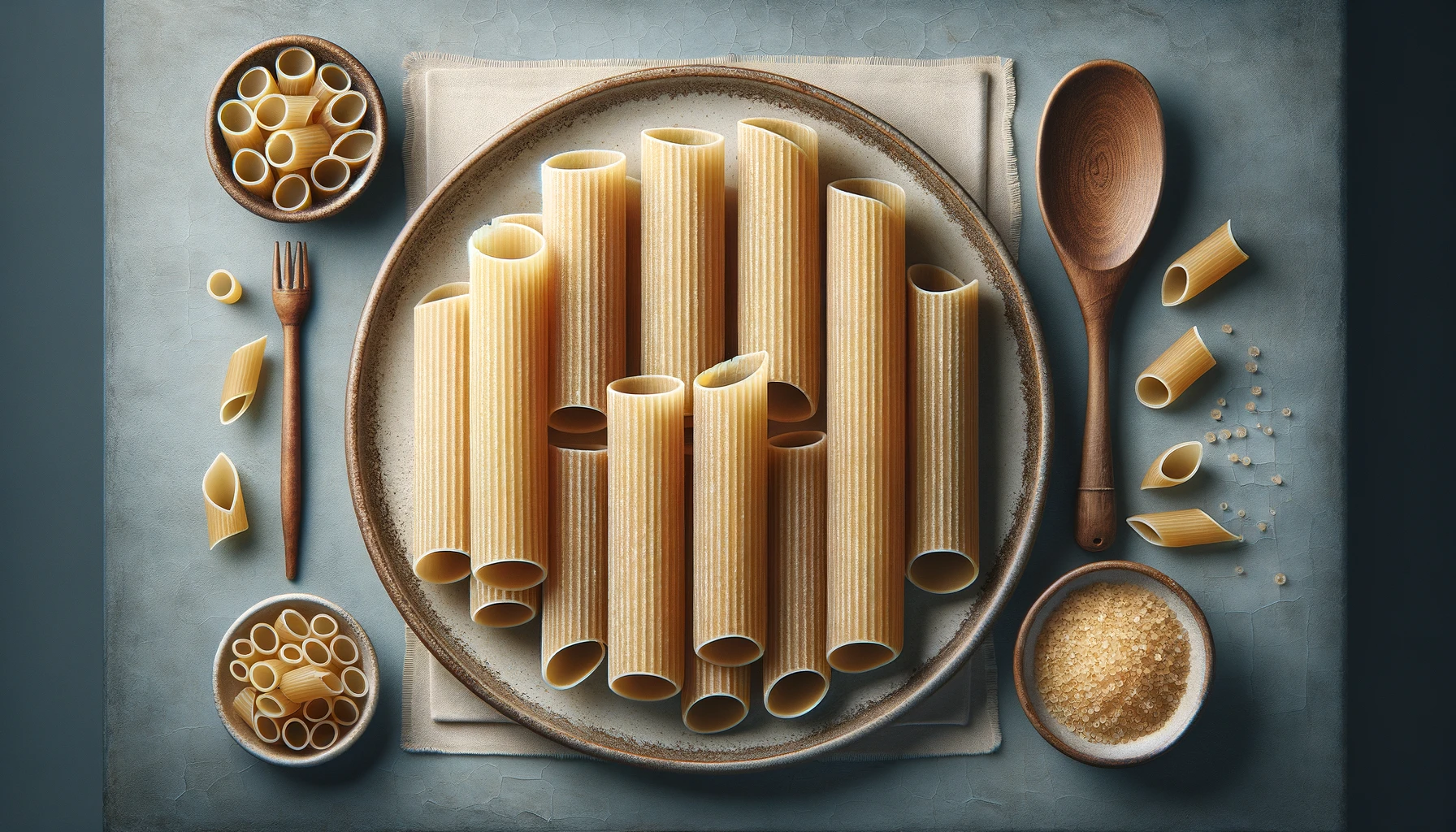
Cannelloni, which means “large reeds” in Italian, are cylindrical pasta tubes that are stuffed and baked. Originating from Italy, this dish became popular in the early 20th century. Cannelloni are typically filled with a mixture of ricotta and spinach or with ground meat, then covered in a tomato or béchamel sauce and baked to perfection.
Main Differences
Cannelloni’s large tube shape allows for generous fillings, distinguishing it from smaller stuffed pastas. Unlike ravioli or tortellini, cannelloni are not sealed around the edges, and the pasta itself is more of a container for the filling.
Advantages and Disadvantages
The advantage of cannelloni lies in its ability to serve as a hearty main dish, with each tube packed with flavor. The primary disadvantage is the additional preparation time required to stuff and bake the pasta, making it more suited for special occasions than a quick meal.
Best Suited Dishes and Famous Dishes
Cannelloni filled with ricotta and spinach, topped with a béchamel sauce, is a classic vegetarian option. Meat-filled cannelloni, baked in a tomato sauce and topped with melted cheese, offers a satisfying and comforting dish ideal for family dinners.
19 Manicotti

Manicotti, meaning “little sleeves” in Italian, are large pasta tubes that are designed to be stuffed and baked. Similar to cannelloni, manicotti is a favorite in Italian-American cuisine, where it’s commonly filled with ricotta cheese, spinach, and sometimes ground meat, then baked in a tomato sauce. The distinction between manicotti and cannelloni often lies in the pasta’s texture, with manicotti shells typically having a ridged surface.
Main Differences
Manicotti’s ridged tubes are slightly larger than cannelloni, making them ideal for chunky fillings. The ridges on the pasta also help to hold the sauce, enhancing the flavor and texture of the dish.
Advantages and Disadvantages
The advantage of manicotti is its ability to encapsulate hearty fillings, providing a robust and satisfying meal. The disadvantage is similar to that of cannelloni, requiring a bit more effort in preparation and baking time, which might not suit every cooking occasion.
Best Suited Dishes and Famous Dishes
Manicotti filled with a mixture of ricotta, mozzarella, and Parmesan cheeses, seasoned with herbs and baked in a marinara sauce, is a classic preparation. This dish is often served at gatherings and special occasions, offering a comforting and indulgent pasta experience.
Soup Pasta
20 Orzo

Orzo, resembling large grains of rice or barley, is a small, rice-shaped pasta that is versatile and popular in various cuisines, not just Italian. Its name, “orzo,” means “barley” in Italian, alluding to its grain-like appearance. This pasta has found its place in Mediterranean, Middle Eastern, and European dishes, showcasing its adaptability in a range of recipes from soups to salads and pilafs.
Main Differences
Orzo’s primary distinction lies in its shape, which is quite different from the traditional pasta cuts. Its size and form allow it to be used in a variety of dishes that pasta typically isn’t associated with, such as being a substitute for rice in pilafs or added to salads for a unique texture.
Advantages and Disadvantages
The advantage of orzo is its quick cooking time and ability to blend seamlessly into a multitude of dishes, absorbing flavors beautifully. However, its small size can lead to overcooking if not monitored closely, potentially resulting in a mushy texture.
Best Suited Dishes and Famous Dishes
Orzo is excellent in brothy soups, where it adds substance without overpowering the other ingredients, such as in Italian Wedding Soup. It’s also popular in cold salads mixed with vegetables and feta cheese or used in warm side dishes with herbs and Parmesan. Orzo risotto is a creative twist on the traditional rice-based dish, offering a different texture but equally creamy result.
21 Ditalini

Ditalini, meaning “little thimbles” in Italian, is a type of pasta that is typically used in soups. Its small, tube-shaped cut makes it perfect for adding texture to brothy dishes. This pasta is particularly popular in the southern regions of Italy and is often associated with comfort food, especially when served in hearty legume soups or cold pasta salads.
Main Differences
Ditalini’s short tube shape and small size set it apart from longer pasta varieties. It is specifically designed to complement soups and salads, where its size allows it to mix well with other ingredients without dominating the dish.
Advantages and Disadvantages
The advantage of ditalini is its versatility in soups and salads, providing a satisfying bite that enhances the dish’s overall texture. One potential disadvantage is that its small size can sometimes get lost in very chunky or thick preparations.
Best Suited Dishes and Famous Dishes
Ditalini is famously used in Pasta e Fagioli, an Italian bean and pasta soup known for its comforting and hearty nature. It’s also a key ingredient in Minestrone, adding texture and substance to this vegetable soup.
22 Acini di Pepe
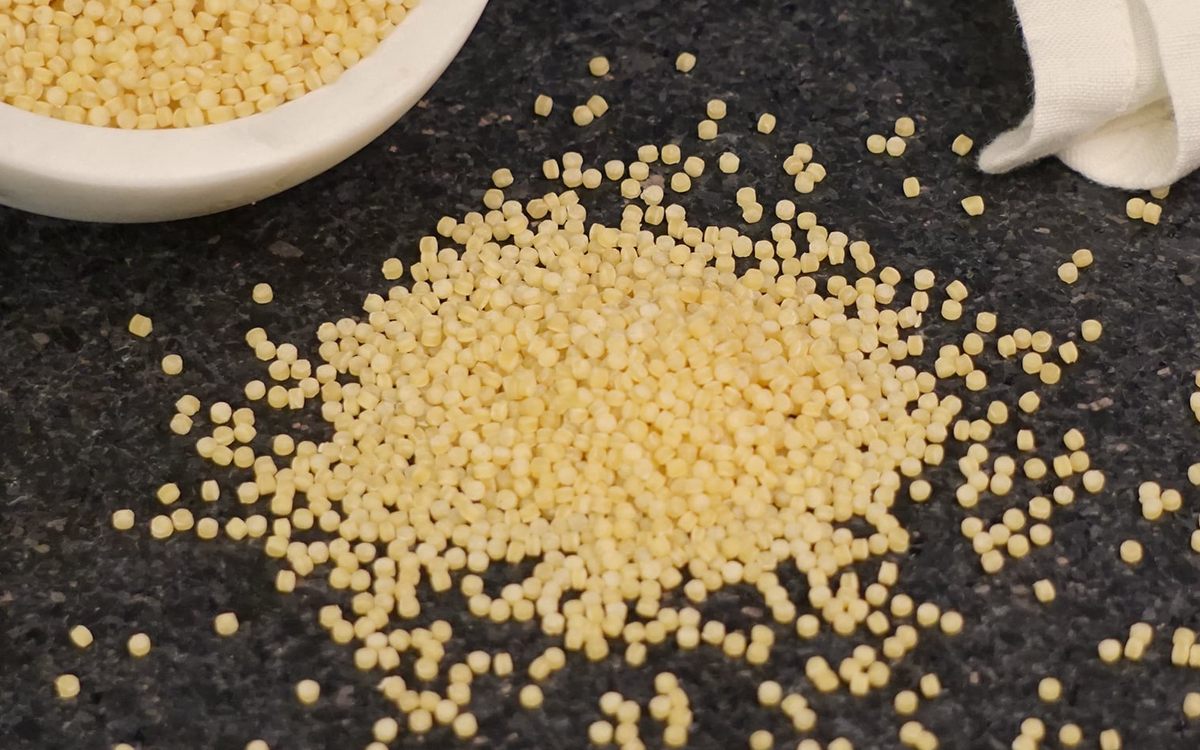
Acini di pepe, translating to “peppercorns” in Italian, is a tiny, bead-shaped pasta that’s often used in soups, salads, and as a playful addition to dishes needing a small pasta variety. Its unique shape makes it ideal for lighter dishes where the pasta should complement rather than dominate the dish. Acini di pepe is particularly favored in Italian and Mediterranean cooking for its ability to add texture and interest to a variety of recipes.
Main Differences
The distinguishing feature of acini di pepe is its very small, round shape, making it one of the tiniest pasta varieties available. This size allows it to be a versatile component in both savory and sweet dishes.
Advantages and Disadvantages
An advantage of acini di pepe is its quick cooking time and the delightful texture it adds to dishes. However, due to its small size, it can easily be overcooked and turn mushy if not carefully watched.
Best Suited Dishes and Famous Dishes
Acini di pepe is excellent in light broths or soups, where it provides a subtle textural contrast. It’s also used in cold pasta salads and can even be a key ingredient in sweet, creamy desserts like Frog Eye Salad, showcasing its versatility beyond traditional savory dishes.
23 Stelline
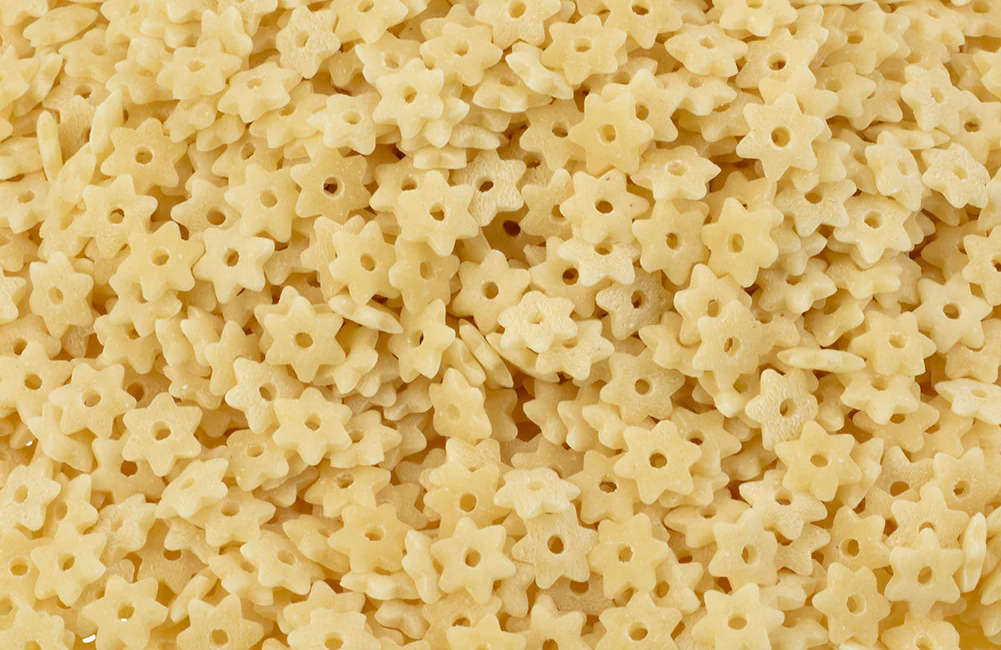
Stelline, meaning “little stars” in Italian, is a charming star-shaped pasta that is particularly popular in soups and dishes intended for children, thanks to its playful shape and small size. This pasta adds a visually appealing element to dishes, making it a favorite for enhancing the presentation and enjoyment of simple recipes.
Main Differences
The star shape of stelline sets it apart from other pasta shapes, designed to be both visually appealing and functional in soups and broths, where it can absorb flavors well while maintaining its form.
Advantages and Disadvantages
The primary advantage of stelline is its ability to make dishes more appealing, especially to children, and its suitability for light soups and broths. A disadvantage could be its tendency to overcook quickly due to its small size, requiring attentive cooking.
Best Suited Dishes and Famous Dishes
Stelline is most commonly found in clear broths and soups, where it adds texture and visual interest without overwhelming the other ingredients. It’s an ideal choice for light vegetable broths or as a garnish in more substantial soups, adding a touch of whimsy to the dining experience.
Unique Shapes
24 Gnocchi
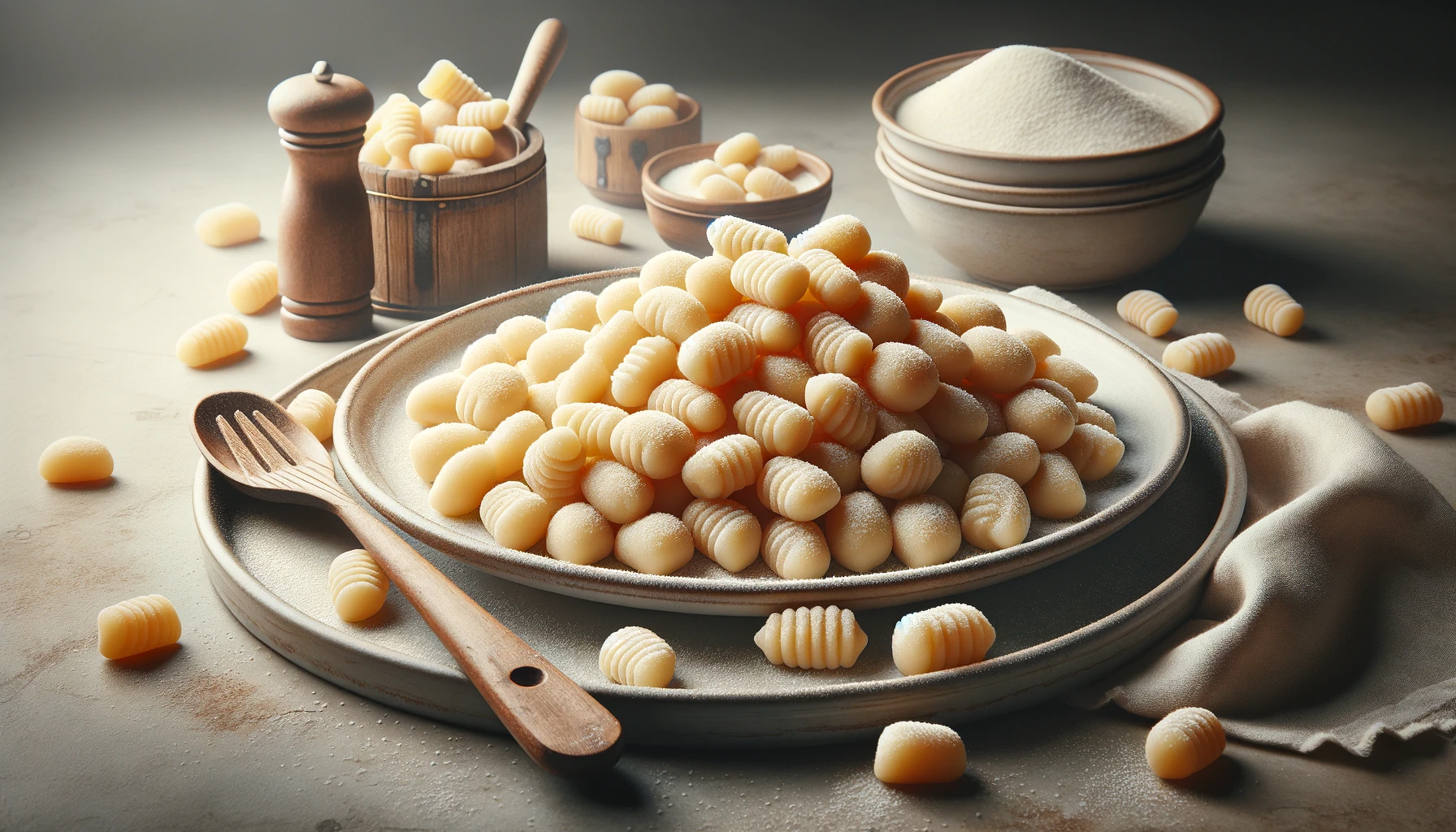
Gnocchi are soft dough dumplings, a cherished part of Italian cuisine with roots that can be traced back to Roman times. Traditionally made from potatoes, flour, and eggs, gnocchi are a testament to the Italian knack for creating substantial dishes from simple ingredients. Regions across Italy have their own variations, incorporating different flours or additions like ricotta.
Main Differences
Unlike pasta made from durum wheat semolina, gnocchi is primarily potato-based, offering a distinctively soft, pillowy texture. Their small, rounded shapes with ridges or indentations set them apart, designed to hold onto sauces effectively.
Advantages and Disadvantages
The advantage of gnocchi lies in their comforting texture and the way they serve as a hearty base for a variety of sauces. However, making gnocchi from scratch requires some skill to achieve the right texture without them becoming too dense or falling apart during cooking.
Best Suited Dishes and Famous Dishes
Gnocchi is famously served with a sage and butter sauce (Gnocchi alla Salvia), pesto, or a simple yet rich tomato basil sauce. Gnocchi alla Sorrentina includes baked gnocchi in tomato sauce topped with mozzarella and basil, showcasing the dumplings’ versatility.
25 Lasagne
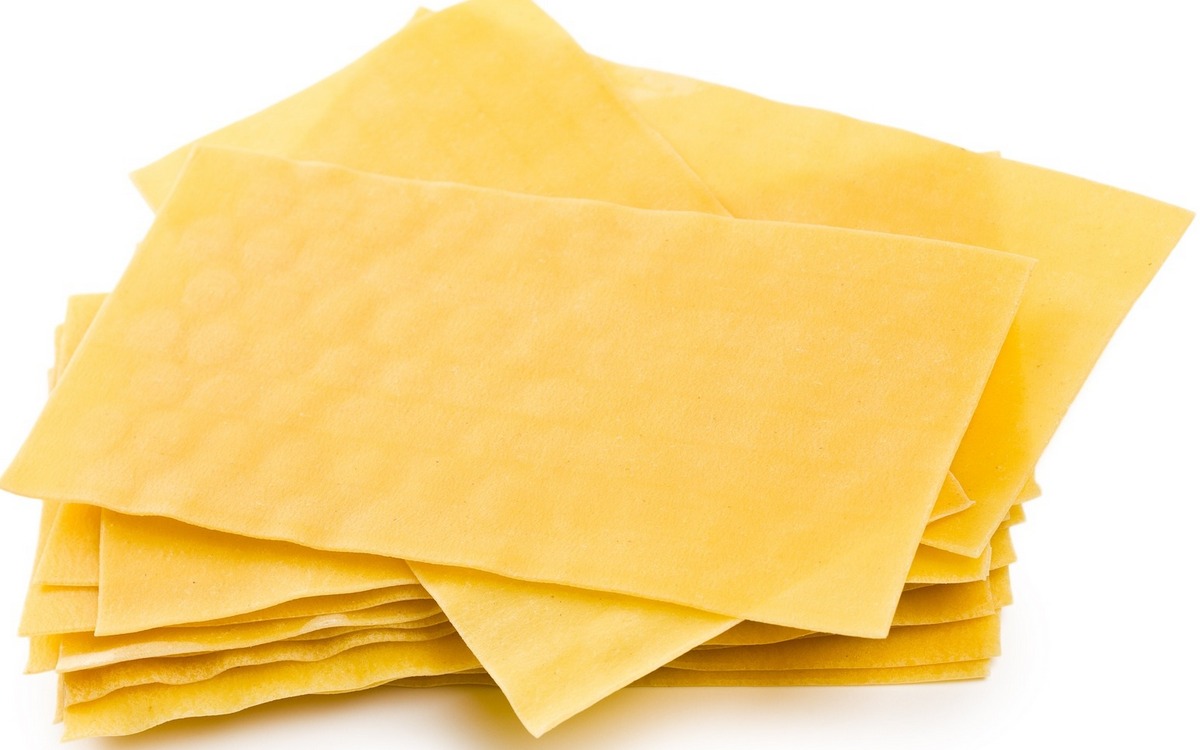
Lasagne, one of the oldest types of pasta, is a flat, wide sheet traditionally used in layered baked dishes. The origins of lasagne are debated, with some tracing it back to ancient Greece and others to medieval Italy. It has become synonymous with the Emilia-Romagna region, where it is perfected as Lasagne alla Bolognese. This version features layers of pasta sheets, ragù (meat sauce), béchamel sauce, and Parmigiano-Reggiano cheese.
Main Differences
Lasagne sheets are unique due to their size and the fact that they are used in layers to create a dish, rather than being served with sauce on top like most other pasta types. Their broad, flat surface is ideal for layering and baking.
Advantages and Disadvantages
The main advantage of lasagne is its ability to create complex, hearty dishes that are perfect for feeding a crowd. The layered construction allows for a harmonious blend of flavors and textures. A potential disadvantage is the time and effort required to assemble and bake a lasagne dish.
Best Suited Dishes and Famous Dishes
Lasagne alla Bolognese is the quintessential lasagne dish, featuring alternating layers of homemade pasta, ragù, béchamel sauce, and grated Parmigiano-Reggiano. Variations include vegetarian lasagne with spinach and ricotta or modern interpretations with different meats and cheeses.
26 Bucatini
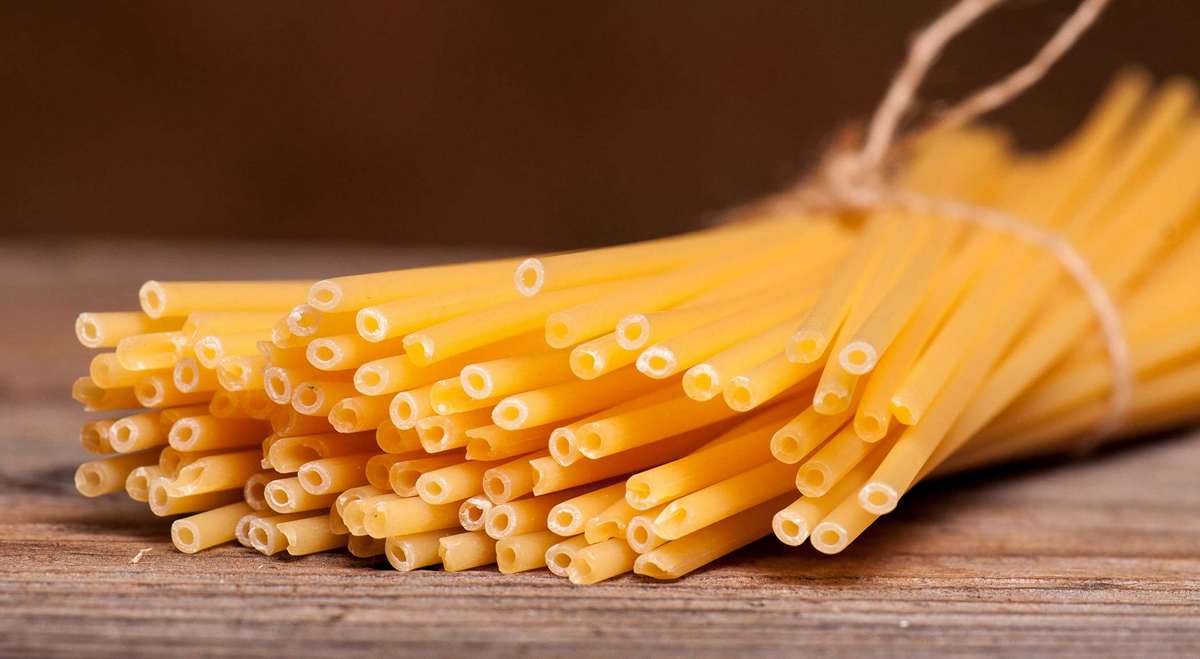
Bucatini, also known as perciatelli, is a thick, spaghetti-like pasta with a hollow center running through its length. Bucatini, originating from the Lazio region, especially Rome, is often associated with the classic dish Bucatini all’Amatriciana. This dish features a spicy tomato sauce with guanciale (cured pork cheek) and Pecorino Romano cheese.
Main Differences
The hollow center of bucatini sets it apart from other spaghetti-type pasta, allowing it to capture sauce both inside and outside the noodle, creating a unique flavor experience with each bite.
Advantages and Disadvantages
The advantage of bucatini lies in its texture and the way it holds onto sauces, offering a more substantial bite than spaghetti. However, its thickness can lead to longer cooking times, and the hollow center may pose a challenge for even cooking.
Best Suited Dishes and Famous Dishes
Bucatini all’Amatriciana is the most renowned dish featuring this pasta, celebrated for its rich, spicy sauce that clings to the bucatini. It also serves as a robust alternative to traditional spaghetti in dishes like Bucatini alla Carbonara.
27 Conchiglie (Shells)
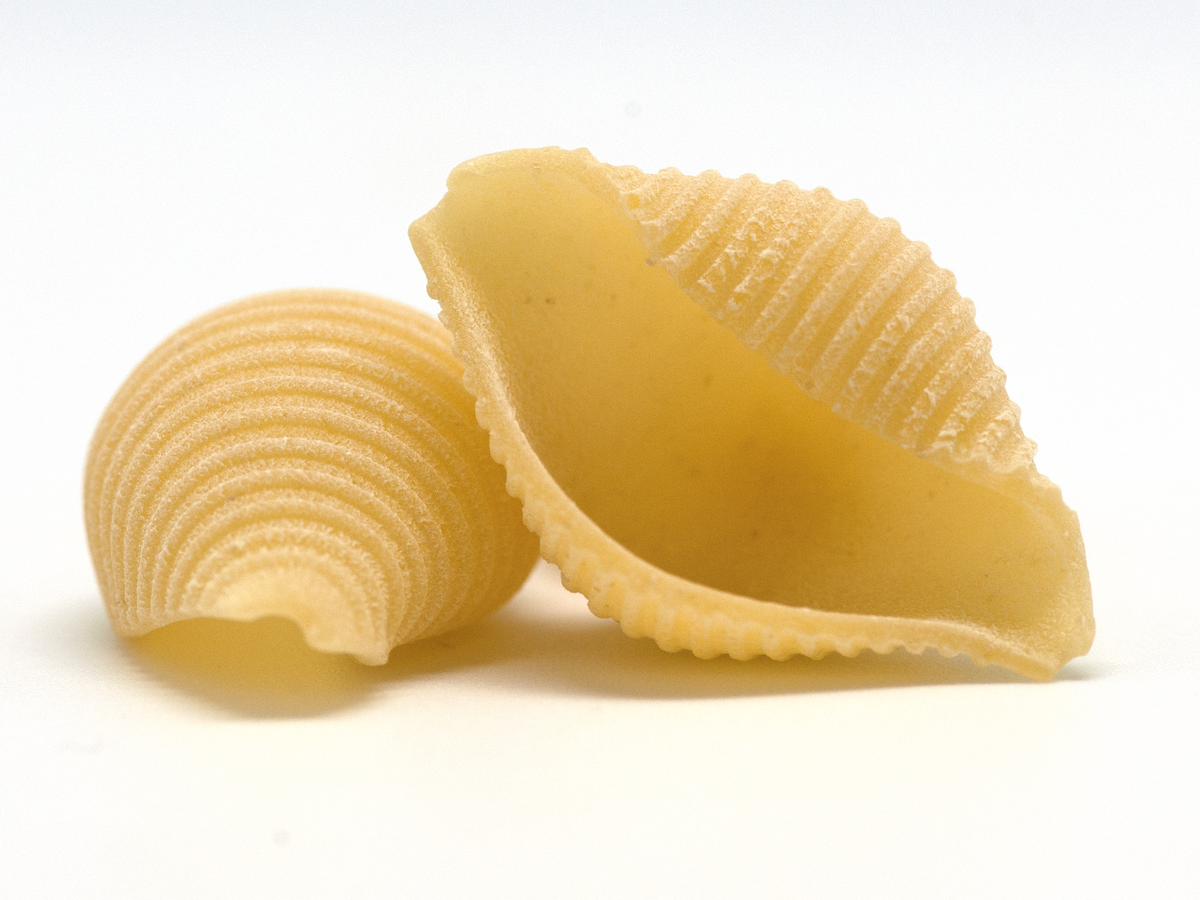
Named for its resemblance to a conch shell, Conchiglie is a pasta variety that comes in different sizes, ranging from tiny shells perfect for soups to large shells suitable for stuffing and baking. The shell shape is ideal for catching and holding onto sauces, making conchiglie a favorite in both Italian and international cuisines for its decorative appearance and practical design.
Main Differences
The shell shape of conchiglie, featuring ridges and a hollow center, is designed to scoop up sauces, small bits of meat, vegetables, or cheese, ensuring a flavorful bite every time.
Advantages and Disadvantages
The advantage of conchiglie is its versatility and effectiveness in a wide range of dishes, from simple pasta salads to hearty baked casseroles. However, it’s essential to cook the larger stuffed varieties carefully to ensure they are fully cooked without becoming mushy.
Best Suited Dishes and Famous Dishes
Conchiglie, with its shell-like shape, excels at holding chunky sauces or in pasta salads, catching small pieces of vegetables and dressing. You can stuff large conchiglie with combinations such as ricotta and spinach or ground meat, then bake them with tomato sauce and mozzarella topping for a satisfying main course.
Final Words
This exploration of pasta has taken us through a delightful variety of shapes, textures, and flavors that define the essence of Italian cuisine. From the comforting pillows of gnocchi to the elegant strands of spaghetti and the playful twists of fusilli, each type of pasta offers a unique canvas for culinary creativity. It’s important to remember that pasta’s beauty lies not only in its diversity but in its ability to bring people together. I hope you’ll have fun experimenting with these 27 varieties in your kitchen, and that every meal will be a chance to discover a new favorite dish. Buon appetito!
